Consumer Behavior Assignment PDF
VerifiedAdded on 2022/01/17
|20
|6093
|297
AI Summary
Contribute Materials
Your contribution can guide someone’s learning journey. Share your
documents today.
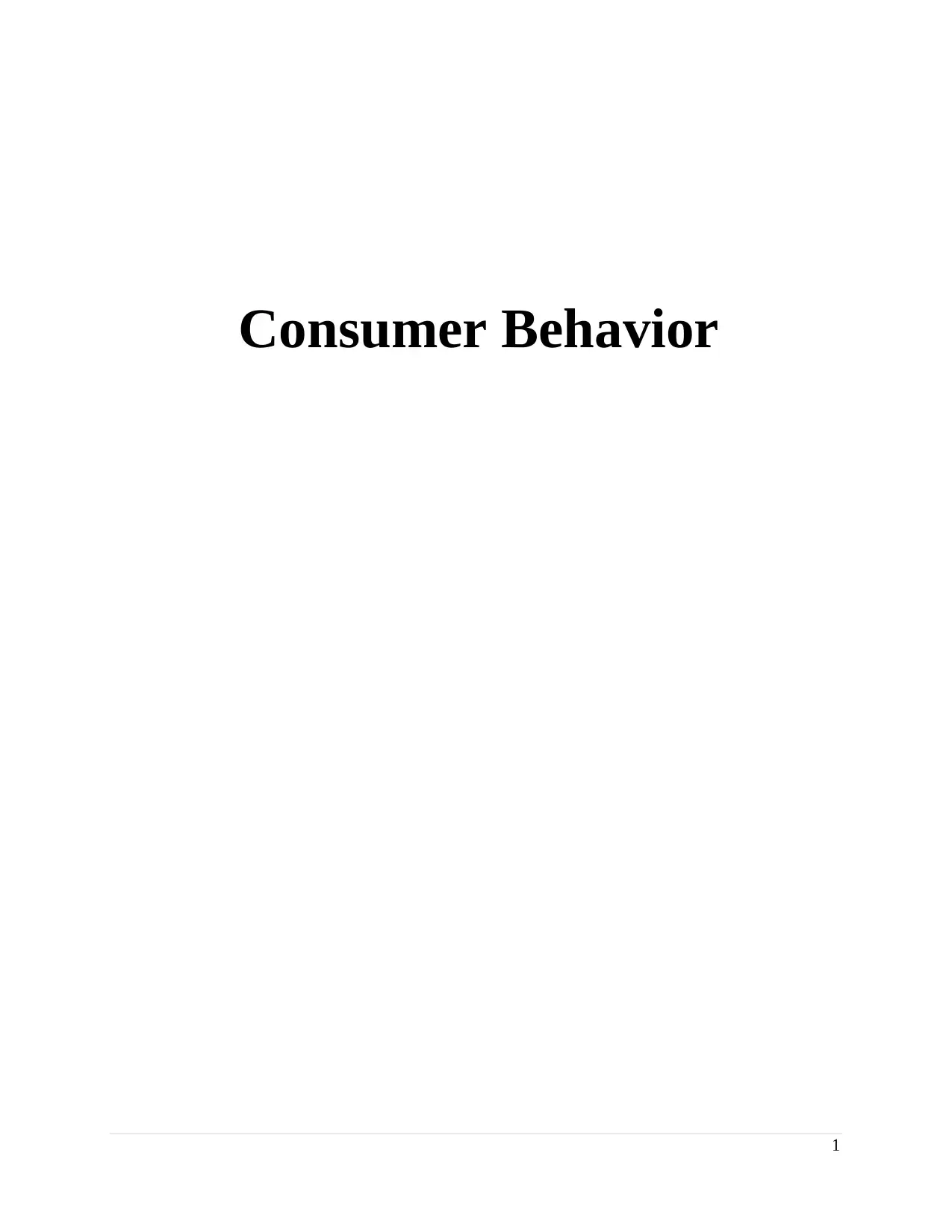
1
Consumer Behavior
Consumer Behavior
Secure Best Marks with AI Grader
Need help grading? Try our AI Grader for instant feedback on your assignments.
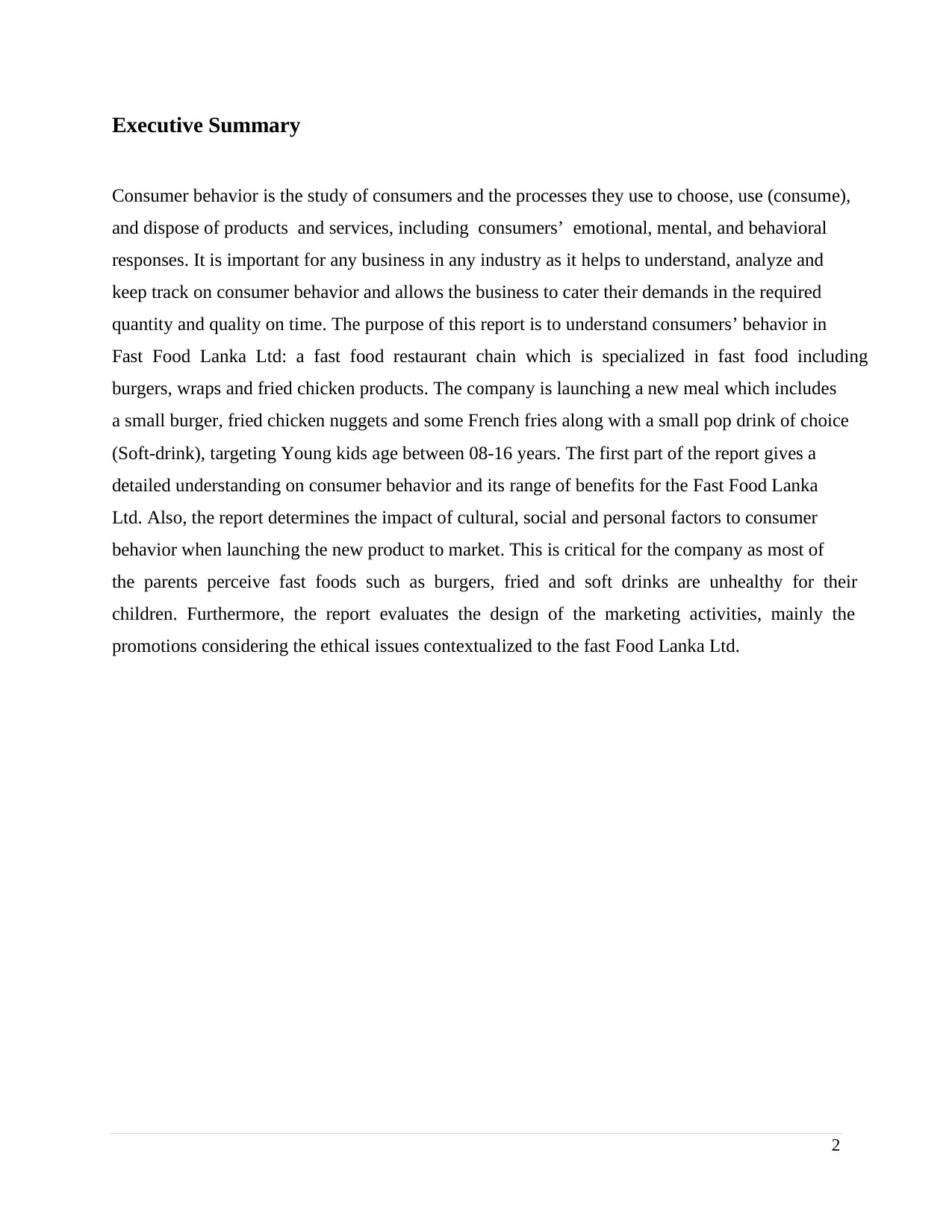
2
Executive Summary
Consumer behavior is the study of consumers and the processes they use to choose, use (consume),
and dispose of products and services, including consumers’ emotional, mental, and behavioral
responses. It is important for any business in any industry as it helps to understand, analyze and
keep track on consumer behavior and allows the business to cater their demands in the required
quantity and quality on time. The purpose of this report is to understand consumers’ behavior in
Fast Food Lanka Ltd: a fast food restaurant chain which is specialized in fast food including
burgers, wraps and fried chicken products. The company is launching a new meal which includes
a small burger, fried chicken nuggets and some French fries along with a small pop drink of choice
(Soft-drink), targeting Young kids age between 08-16 years. The first part of the report gives a
detailed understanding on consumer behavior and its range of benefits for the Fast Food Lanka
Ltd. Also, the report determines the impact of cultural, social and personal factors to consumer
behavior when launching the new product to market. This is critical for the company as most of
the parents perceive fast foods such as burgers, fried and soft drinks are unhealthy for their
children. Furthermore, the report evaluates the design of the marketing activities, mainly the
promotions considering the ethical issues contextualized to the fast Food Lanka Ltd.
Executive Summary
Consumer behavior is the study of consumers and the processes they use to choose, use (consume),
and dispose of products and services, including consumers’ emotional, mental, and behavioral
responses. It is important for any business in any industry as it helps to understand, analyze and
keep track on consumer behavior and allows the business to cater their demands in the required
quantity and quality on time. The purpose of this report is to understand consumers’ behavior in
Fast Food Lanka Ltd: a fast food restaurant chain which is specialized in fast food including
burgers, wraps and fried chicken products. The company is launching a new meal which includes
a small burger, fried chicken nuggets and some French fries along with a small pop drink of choice
(Soft-drink), targeting Young kids age between 08-16 years. The first part of the report gives a
detailed understanding on consumer behavior and its range of benefits for the Fast Food Lanka
Ltd. Also, the report determines the impact of cultural, social and personal factors to consumer
behavior when launching the new product to market. This is critical for the company as most of
the parents perceive fast foods such as burgers, fried and soft drinks are unhealthy for their
children. Furthermore, the report evaluates the design of the marketing activities, mainly the
promotions considering the ethical issues contextualized to the fast Food Lanka Ltd.
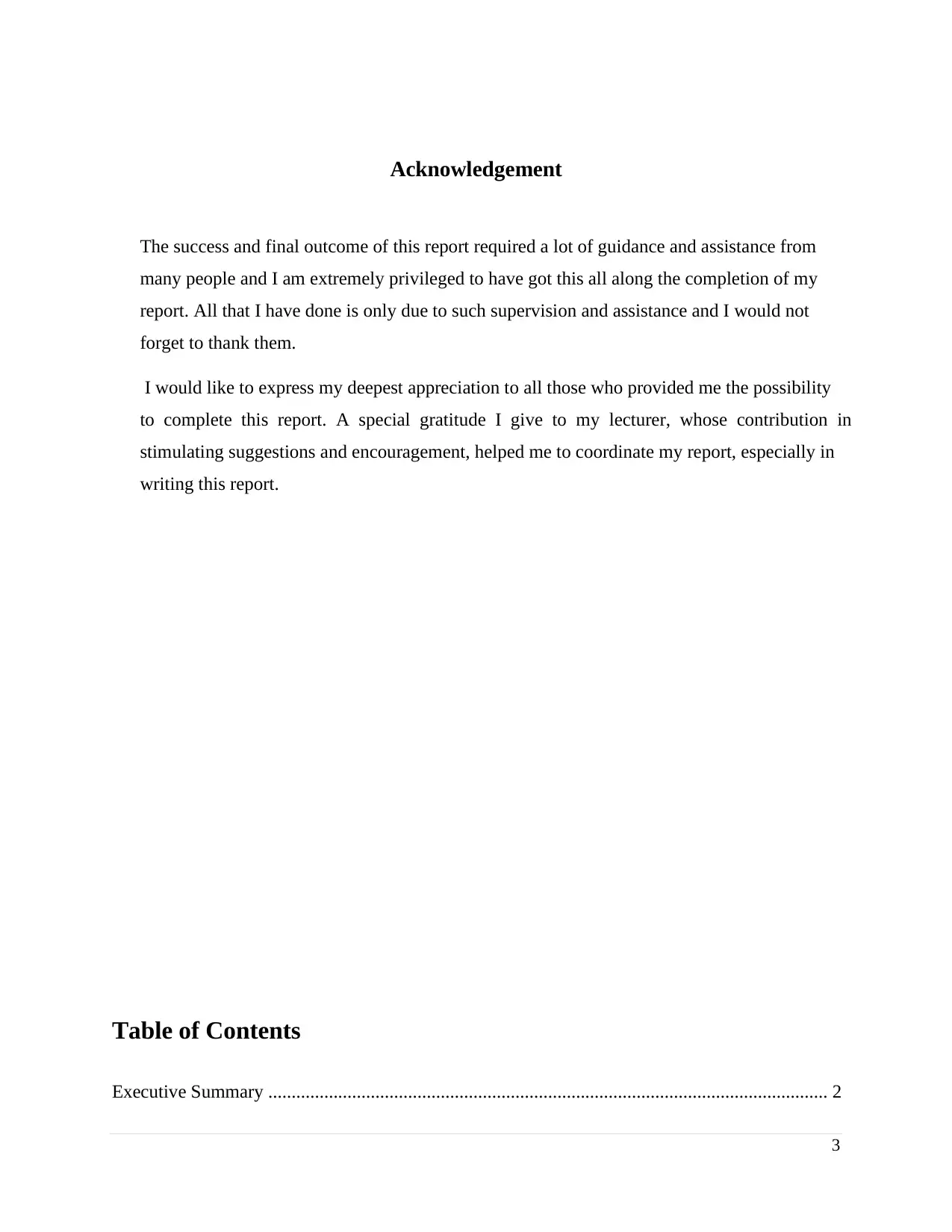
3
Acknowledgement
The success and final outcome of this report required a lot of guidance and assistance from
many people and I am extremely privileged to have got this all along the completion of my
report. All that I have done is only due to such supervision and assistance and I would not
forget to thank them.
I would like to express my deepest appreciation to all those who provided me the possibility
to complete this report. A special gratitude I give to my lecturer, whose contribution in
stimulating suggestions and encouragement, helped me to coordinate my report, especially in
writing this report.
Table of Contents
Executive Summary ........................................................................................................................ 2
Acknowledgement
The success and final outcome of this report required a lot of guidance and assistance from
many people and I am extremely privileged to have got this all along the completion of my
report. All that I have done is only due to such supervision and assistance and I would not
forget to thank them.
I would like to express my deepest appreciation to all those who provided me the possibility
to complete this report. A special gratitude I give to my lecturer, whose contribution in
stimulating suggestions and encouragement, helped me to coordinate my report, especially in
writing this report.
Table of Contents
Executive Summary ........................................................................................................................ 2
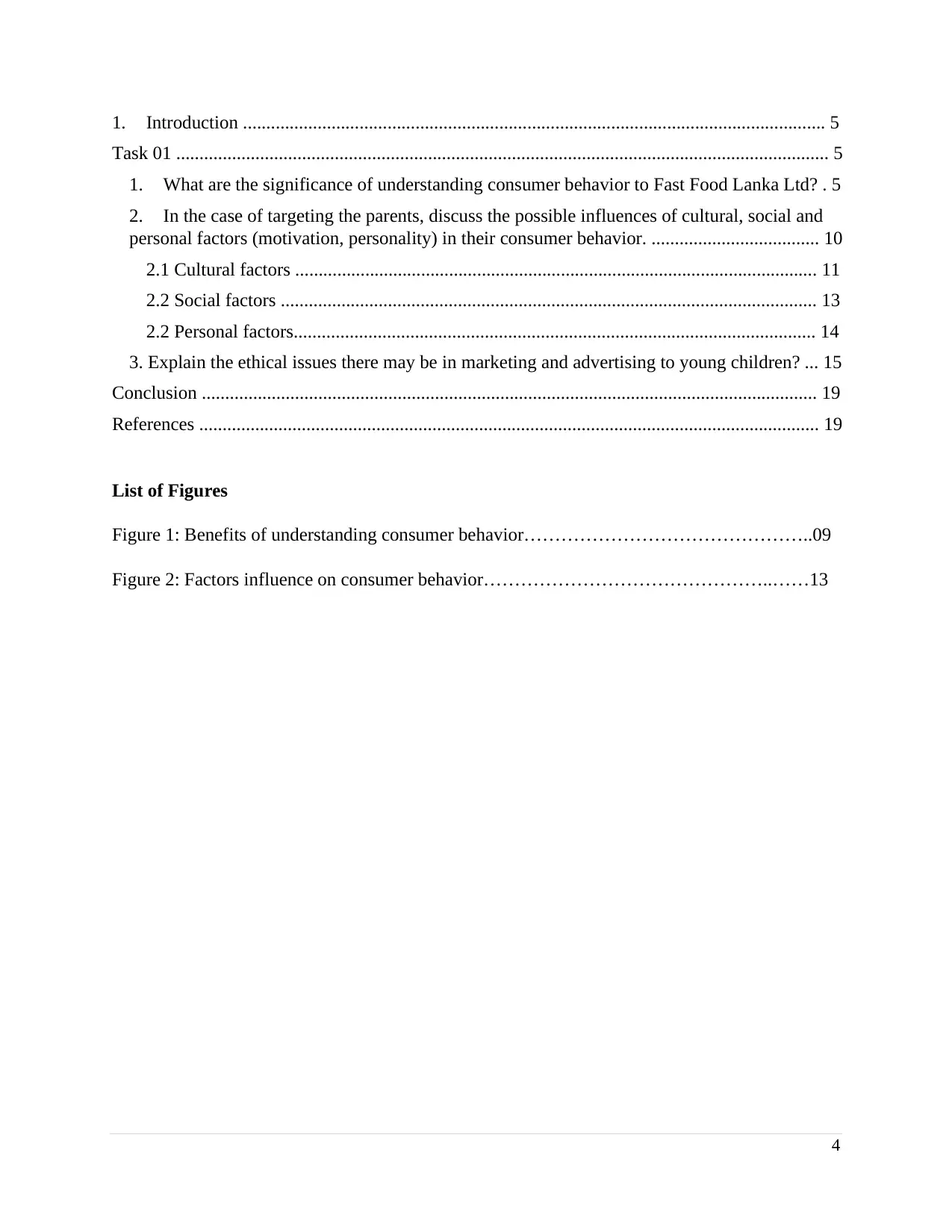
4
1. Introduction ............................................................................................................................. 5
Task 01 ............................................................................................................................................ 5
1. What are the significance of understanding consumer behavior to Fast Food Lanka Ltd? . 5
2. In the case of targeting the parents, discuss the possible influences of cultural, social and
personal factors (motivation, personality) in their consumer behavior. .................................... 10
2.1 Cultural factors ................................................................................................................ 11
2.2 Social factors ................................................................................................................... 13
2.2 Personal factors................................................................................................................ 14
3. Explain the ethical issues there may be in marketing and advertising to young children? ... 15
Conclusion .................................................................................................................................... 19
References ..................................................................................................................................... 19
List of Figures
Figure 1: Benefits of understanding consumer behavior………………………………………..09
Figure 2: Factors influence on consumer behavior………………………………………..……13
1. Introduction ............................................................................................................................. 5
Task 01 ............................................................................................................................................ 5
1. What are the significance of understanding consumer behavior to Fast Food Lanka Ltd? . 5
2. In the case of targeting the parents, discuss the possible influences of cultural, social and
personal factors (motivation, personality) in their consumer behavior. .................................... 10
2.1 Cultural factors ................................................................................................................ 11
2.2 Social factors ................................................................................................................... 13
2.2 Personal factors................................................................................................................ 14
3. Explain the ethical issues there may be in marketing and advertising to young children? ... 15
Conclusion .................................................................................................................................... 19
References ..................................................................................................................................... 19
List of Figures
Figure 1: Benefits of understanding consumer behavior………………………………………..09
Figure 2: Factors influence on consumer behavior………………………………………..……13
Secure Best Marks with AI Grader
Need help grading? Try our AI Grader for instant feedback on your assignments.
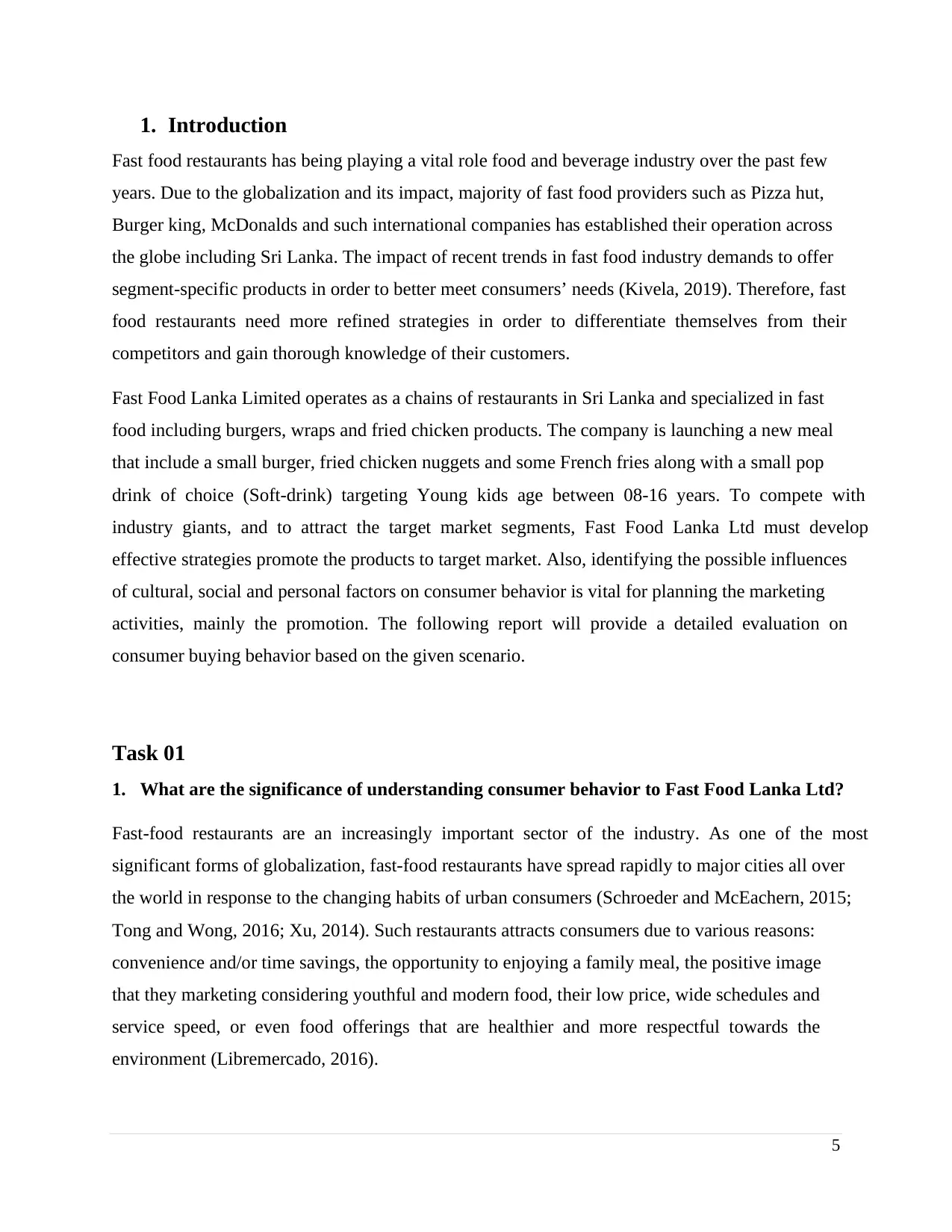
5
1. Introduction
Fast food restaurants has being playing a vital role food and beverage industry over the past few
years. Due to the globalization and its impact, majority of fast food providers such as Pizza hut,
Burger king, McDonalds and such international companies has established their operation across
the globe including Sri Lanka. The impact of recent trends in fast food industry demands to offer
segment-specific products in order to better meet consumers’ needs (Kivela, 2019). Therefore, fast
food restaurants need more refined strategies in order to differentiate themselves from their
competitors and gain thorough knowledge of their customers.
Fast Food Lanka Limited operates as a chains of restaurants in Sri Lanka and specialized in fast
food including burgers, wraps and fried chicken products. The company is launching a new meal
that include a small burger, fried chicken nuggets and some French fries along with a small pop
drink of choice (Soft-drink) targeting Young kids age between 08-16 years. To compete with
industry giants, and to attract the target market segments, Fast Food Lanka Ltd must develop
effective strategies promote the products to target market. Also, identifying the possible influences
of cultural, social and personal factors on consumer behavior is vital for planning the marketing
activities, mainly the promotion. The following report will provide a detailed evaluation on
consumer buying behavior based on the given scenario.
Task 01
1. What are the significance of understanding consumer behavior to Fast Food Lanka Ltd?
Fast-food restaurants are an increasingly important sector of the industry. As one of the most
significant forms of globalization, fast-food restaurants have spread rapidly to major cities all over
the world in response to the changing habits of urban consumers (Schroeder and McEachern, 2015;
Tong and Wong, 2016; Xu, 2014). Such restaurants attracts consumers due to various reasons:
convenience and/or time savings, the opportunity to enjoying a family meal, the positive image
that they marketing considering youthful and modern food, their low price, wide schedules and
service speed, or even food offerings that are healthier and more respectful towards the
environment (Libremercado, 2016).
1. Introduction
Fast food restaurants has being playing a vital role food and beverage industry over the past few
years. Due to the globalization and its impact, majority of fast food providers such as Pizza hut,
Burger king, McDonalds and such international companies has established their operation across
the globe including Sri Lanka. The impact of recent trends in fast food industry demands to offer
segment-specific products in order to better meet consumers’ needs (Kivela, 2019). Therefore, fast
food restaurants need more refined strategies in order to differentiate themselves from their
competitors and gain thorough knowledge of their customers.
Fast Food Lanka Limited operates as a chains of restaurants in Sri Lanka and specialized in fast
food including burgers, wraps and fried chicken products. The company is launching a new meal
that include a small burger, fried chicken nuggets and some French fries along with a small pop
drink of choice (Soft-drink) targeting Young kids age between 08-16 years. To compete with
industry giants, and to attract the target market segments, Fast Food Lanka Ltd must develop
effective strategies promote the products to target market. Also, identifying the possible influences
of cultural, social and personal factors on consumer behavior is vital for planning the marketing
activities, mainly the promotion. The following report will provide a detailed evaluation on
consumer buying behavior based on the given scenario.
Task 01
1. What are the significance of understanding consumer behavior to Fast Food Lanka Ltd?
Fast-food restaurants are an increasingly important sector of the industry. As one of the most
significant forms of globalization, fast-food restaurants have spread rapidly to major cities all over
the world in response to the changing habits of urban consumers (Schroeder and McEachern, 2015;
Tong and Wong, 2016; Xu, 2014). Such restaurants attracts consumers due to various reasons:
convenience and/or time savings, the opportunity to enjoying a family meal, the positive image
that they marketing considering youthful and modern food, their low price, wide schedules and
service speed, or even food offerings that are healthier and more respectful towards the
environment (Libremercado, 2016).
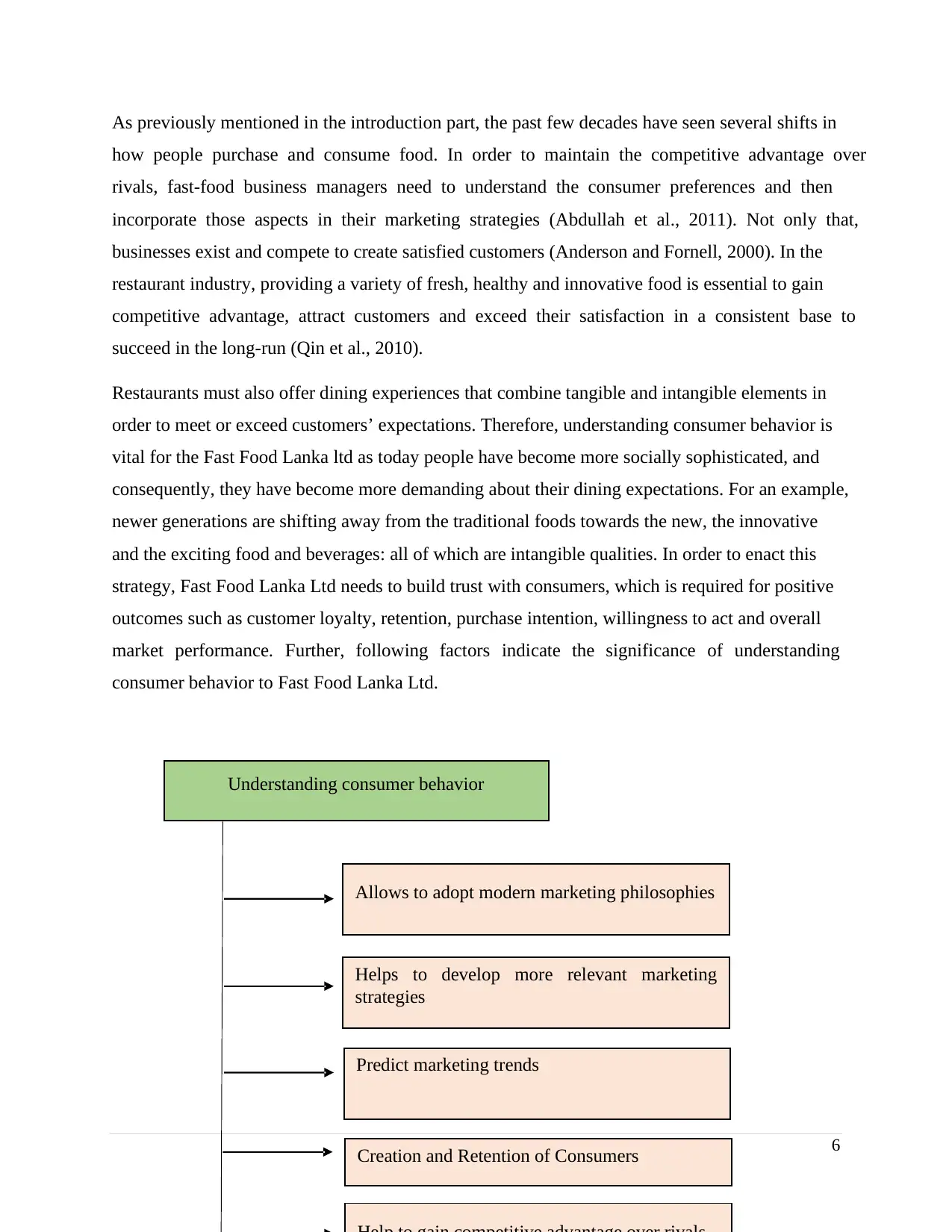
6
As previously mentioned in the introduction part, the past few decades have seen several shifts in
how people purchase and consume food. In order to maintain the competitive advantage over
rivals, fast-food business managers need to understand the consumer preferences and then
incorporate those aspects in their marketing strategies (Abdullah et al., 2011). Not only that,
businesses exist and compete to create satisfied customers (Anderson and Fornell, 2000). In the
restaurant industry, providing a variety of fresh, healthy and innovative food is essential to gain
competitive advantage, attract customers and exceed their satisfaction in a consistent base to
succeed in the long-run (Qin et al., 2010).
Restaurants must also offer dining experiences that combine tangible and intangible elements in
order to meet or exceed customers’ expectations. Therefore, understanding consumer behavior is
vital for the Fast Food Lanka ltd as today people have become more socially sophisticated, and
consequently, they have become more demanding about their dining expectations. For an example,
newer generations are shifting away from the traditional foods towards the new, the innovative
and the exciting food and beverages: all of which are intangible qualities. In order to enact this
strategy, Fast Food Lanka Ltd needs to build trust with consumers, which is required for positive
outcomes such as customer loyalty, retention, purchase intention, willingness to act and overall
market performance. Further, following factors indicate the significance of understanding
consumer behavior to Fast Food Lanka Ltd.
Understanding consumer behavior
Allows to adopt modern marketing philosophies
Helps to develop more relevant marketing
strategies
Predict marketing trends
Creation and Retention of Consumers
As previously mentioned in the introduction part, the past few decades have seen several shifts in
how people purchase and consume food. In order to maintain the competitive advantage over
rivals, fast-food business managers need to understand the consumer preferences and then
incorporate those aspects in their marketing strategies (Abdullah et al., 2011). Not only that,
businesses exist and compete to create satisfied customers (Anderson and Fornell, 2000). In the
restaurant industry, providing a variety of fresh, healthy and innovative food is essential to gain
competitive advantage, attract customers and exceed their satisfaction in a consistent base to
succeed in the long-run (Qin et al., 2010).
Restaurants must also offer dining experiences that combine tangible and intangible elements in
order to meet or exceed customers’ expectations. Therefore, understanding consumer behavior is
vital for the Fast Food Lanka ltd as today people have become more socially sophisticated, and
consequently, they have become more demanding about their dining expectations. For an example,
newer generations are shifting away from the traditional foods towards the new, the innovative
and the exciting food and beverages: all of which are intangible qualities. In order to enact this
strategy, Fast Food Lanka Ltd needs to build trust with consumers, which is required for positive
outcomes such as customer loyalty, retention, purchase intention, willingness to act and overall
market performance. Further, following factors indicate the significance of understanding
consumer behavior to Fast Food Lanka Ltd.
Understanding consumer behavior
Allows to adopt modern marketing philosophies
Helps to develop more relevant marketing
strategies
Predict marketing trends
Creation and Retention of Consumers

7
Figure 1: Benefits of understanding consumer behavior
1. Allows to adopt modern marketing philosophies
Due to the globalization and recent trends, new marketing philosophies are emerging in fast food
restaurant industry (Business Insider, 2018). Consumer behavior is an essential indicator when
developing marketing strategies for an organization and it concerns with modern marketing
philosophies as well. It allows the company to identify consumer needs and exceed their
satisfaction more effectively than competitors (Williams, 2018). It makes marketing consumer-
oriented. It is the key to succeed.
For an example: if we take fast food industry giant, Burger King’s marketing philosophy:
Burger King uses demographic and geographic segmentation variables in order to cater the
changing taste & preferences of the consumers globally.
It uses differentiated targeting strategy so as to address the needs of the customers
accordingly.
Thus, Fast Food Lanka can position themselves by considering on the serviceability &
convenience factors. Also, they are offering the new product to the market by mainly targeting the
young kids who are in between age of 08-16 years. Therefore, Fast Food Lanka can use the
demographic segmentation to attract potential consumers who are in between age 08-16 by
adapting effective advertisement strategies accordingly. This will allow them to be more
Figure 1: Benefits of understanding consumer behavior
1. Allows to adopt modern marketing philosophies
Due to the globalization and recent trends, new marketing philosophies are emerging in fast food
restaurant industry (Business Insider, 2018). Consumer behavior is an essential indicator when
developing marketing strategies for an organization and it concerns with modern marketing
philosophies as well. It allows the company to identify consumer needs and exceed their
satisfaction more effectively than competitors (Williams, 2018). It makes marketing consumer-
oriented. It is the key to succeed.
For an example: if we take fast food industry giant, Burger King’s marketing philosophy:
Burger King uses demographic and geographic segmentation variables in order to cater the
changing taste & preferences of the consumers globally.
It uses differentiated targeting strategy so as to address the needs of the customers
accordingly.
Thus, Fast Food Lanka can position themselves by considering on the serviceability &
convenience factors. Also, they are offering the new product to the market by mainly targeting the
young kids who are in between age of 08-16 years. Therefore, Fast Food Lanka can use the
demographic segmentation to attract potential consumers who are in between age 08-16 by
adapting effective advertisement strategies accordingly. This will allow them to be more
Paraphrase This Document
Need a fresh take? Get an instant paraphrase of this document with our AI Paraphraser
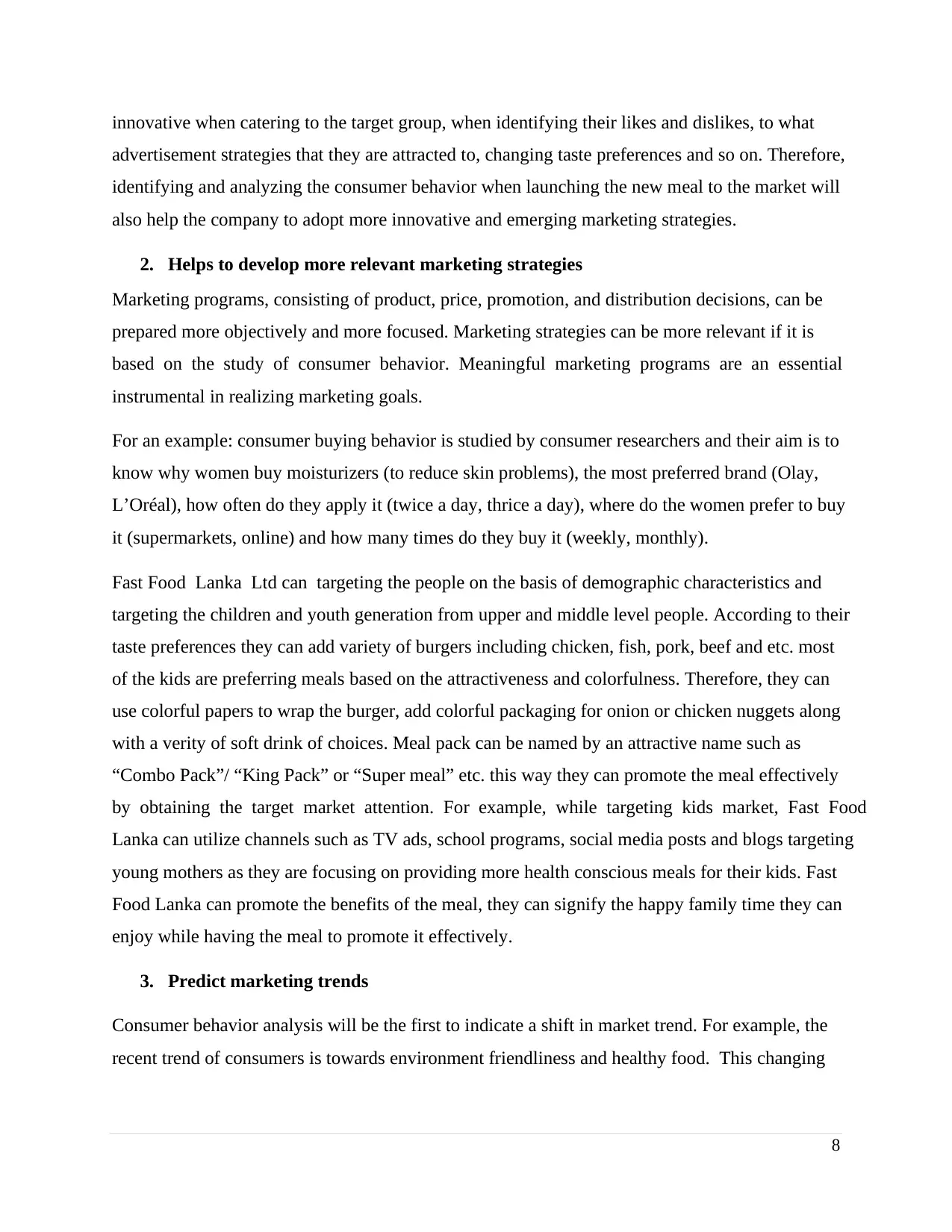
8
innovative when catering to the target group, when identifying their likes and dislikes, to what
advertisement strategies that they are attracted to, changing taste preferences and so on. Therefore,
identifying and analyzing the consumer behavior when launching the new meal to the market will
also help the company to adopt more innovative and emerging marketing strategies.
2. Helps to develop more relevant marketing strategies
Marketing programs, consisting of product, price, promotion, and distribution decisions, can be
prepared more objectively and more focused. Marketing strategies can be more relevant if it is
based on the study of consumer behavior. Meaningful marketing programs are an essential
instrumental in realizing marketing goals.
For an example: consumer buying behavior is studied by consumer researchers and their aim is to
know why women buy moisturizers (to reduce skin problems), the most preferred brand (Olay,
L’Oréal), how often do they apply it (twice a day, thrice a day), where do the women prefer to buy
it (supermarkets, online) and how many times do they buy it (weekly, monthly).
Fast Food Lanka Ltd can targeting the people on the basis of demographic characteristics and
targeting the children and youth generation from upper and middle level people. According to their
taste preferences they can add variety of burgers including chicken, fish, pork, beef and etc. most
of the kids are preferring meals based on the attractiveness and colorfulness. Therefore, they can
use colorful papers to wrap the burger, add colorful packaging for onion or chicken nuggets along
with a verity of soft drink of choices. Meal pack can be named by an attractive name such as
“Combo Pack”/ “King Pack” or “Super meal” etc. this way they can promote the meal effectively
by obtaining the target market attention. For example, while targeting kids market, Fast Food
Lanka can utilize channels such as TV ads, school programs, social media posts and blogs targeting
young mothers as they are focusing on providing more health conscious meals for their kids. Fast
Food Lanka can promote the benefits of the meal, they can signify the happy family time they can
enjoy while having the meal to promote it effectively.
3. Predict marketing trends
Consumer behavior analysis will be the first to indicate a shift in market trend. For example, the
recent trend of consumers is towards environment friendliness and healthy food. This changing
innovative when catering to the target group, when identifying their likes and dislikes, to what
advertisement strategies that they are attracted to, changing taste preferences and so on. Therefore,
identifying and analyzing the consumer behavior when launching the new meal to the market will
also help the company to adopt more innovative and emerging marketing strategies.
2. Helps to develop more relevant marketing strategies
Marketing programs, consisting of product, price, promotion, and distribution decisions, can be
prepared more objectively and more focused. Marketing strategies can be more relevant if it is
based on the study of consumer behavior. Meaningful marketing programs are an essential
instrumental in realizing marketing goals.
For an example: consumer buying behavior is studied by consumer researchers and their aim is to
know why women buy moisturizers (to reduce skin problems), the most preferred brand (Olay,
L’Oréal), how often do they apply it (twice a day, thrice a day), where do the women prefer to buy
it (supermarkets, online) and how many times do they buy it (weekly, monthly).
Fast Food Lanka Ltd can targeting the people on the basis of demographic characteristics and
targeting the children and youth generation from upper and middle level people. According to their
taste preferences they can add variety of burgers including chicken, fish, pork, beef and etc. most
of the kids are preferring meals based on the attractiveness and colorfulness. Therefore, they can
use colorful papers to wrap the burger, add colorful packaging for onion or chicken nuggets along
with a verity of soft drink of choices. Meal pack can be named by an attractive name such as
“Combo Pack”/ “King Pack” or “Super meal” etc. this way they can promote the meal effectively
by obtaining the target market attention. For example, while targeting kids market, Fast Food
Lanka can utilize channels such as TV ads, school programs, social media posts and blogs targeting
young mothers as they are focusing on providing more health conscious meals for their kids. Fast
Food Lanka can promote the benefits of the meal, they can signify the happy family time they can
enjoy while having the meal to promote it effectively.
3. Predict marketing trends
Consumer behavior analysis will be the first to indicate a shift in market trend. For example, the
recent trend of consumers is towards environment friendliness and healthy food. This changing

9
market trend was observed by many brands including McDonalds. Based on the consumer
behavior, McDonald’s brought healthy food options.
For Fast Food Lanka, they can offer innovative healthy burger meals such as:
Offering Slinger burgers which are a blend of beef and mushrooms. These burgers may appeal to
more than the health conscious consumer who may still want some meat in their diet. It’s also cited
as one way of lowering food costs and alleviating the demand for industrial cattle farming
(Business insider, 2019). Also, they can be more innovative by creating fully plant-based burgers
that taste like meat with a lower carbon footprint.
4. Creation and Retention of Consumers
Consumer behavior is not just important to attract new customers, but it is very important to retain
existing customers as well. When a customer is happy about a particular product, he/she will repeat
the purchase. Therefore, marketing the product should be done in such a way that it will convince
customers to buy the product again and again.
For an example: Most of the customers of Burger King are in the age group of 15-40 years in
developing nations and in developed nation’s customers of all age groups prefers the Burger King
fast-food chain. Burger King competes on the basis of product choice, service quality,
convenience etc. These factors has been impacted on retaining customers in the long-run.
For Fast Food Lanka, adding a soft toy, coupons for the next meal, and adding them as members
in a digital platform of Fast Food Lanka will be motivate them to visit the restaurant again. This
will also impact on creating a loyal customer base for the company as well. Therefore, obtaining
consumer behavior can be considered as a vital factor for the Fast Food Lanka.
5. Help to gain competitive advantage over rivals.
Studying consumer behavior facilitates in understanding and facing competition. Based on
consumers’ expectations, Fast Food Lanka can offer products which will help to obtain
competitive advantages (Purdy, 2019). Thus it helps in improving competitive strengths of the
company. For an example, to maintain the competitiveness in the fast food industry due to its
famous and innovative products such as Hamburger, Whopper and many others which are helping
the company to increase its market share.
market trend was observed by many brands including McDonalds. Based on the consumer
behavior, McDonald’s brought healthy food options.
For Fast Food Lanka, they can offer innovative healthy burger meals such as:
Offering Slinger burgers which are a blend of beef and mushrooms. These burgers may appeal to
more than the health conscious consumer who may still want some meat in their diet. It’s also cited
as one way of lowering food costs and alleviating the demand for industrial cattle farming
(Business insider, 2019). Also, they can be more innovative by creating fully plant-based burgers
that taste like meat with a lower carbon footprint.
4. Creation and Retention of Consumers
Consumer behavior is not just important to attract new customers, but it is very important to retain
existing customers as well. When a customer is happy about a particular product, he/she will repeat
the purchase. Therefore, marketing the product should be done in such a way that it will convince
customers to buy the product again and again.
For an example: Most of the customers of Burger King are in the age group of 15-40 years in
developing nations and in developed nation’s customers of all age groups prefers the Burger King
fast-food chain. Burger King competes on the basis of product choice, service quality,
convenience etc. These factors has been impacted on retaining customers in the long-run.
For Fast Food Lanka, adding a soft toy, coupons for the next meal, and adding them as members
in a digital platform of Fast Food Lanka will be motivate them to visit the restaurant again. This
will also impact on creating a loyal customer base for the company as well. Therefore, obtaining
consumer behavior can be considered as a vital factor for the Fast Food Lanka.
5. Help to gain competitive advantage over rivals.
Studying consumer behavior facilitates in understanding and facing competition. Based on
consumers’ expectations, Fast Food Lanka can offer products which will help to obtain
competitive advantages (Purdy, 2019). Thus it helps in improving competitive strengths of the
company. For an example, to maintain the competitiveness in the fast food industry due to its
famous and innovative products such as Hamburger, Whopper and many others which are helping
the company to increase its market share.
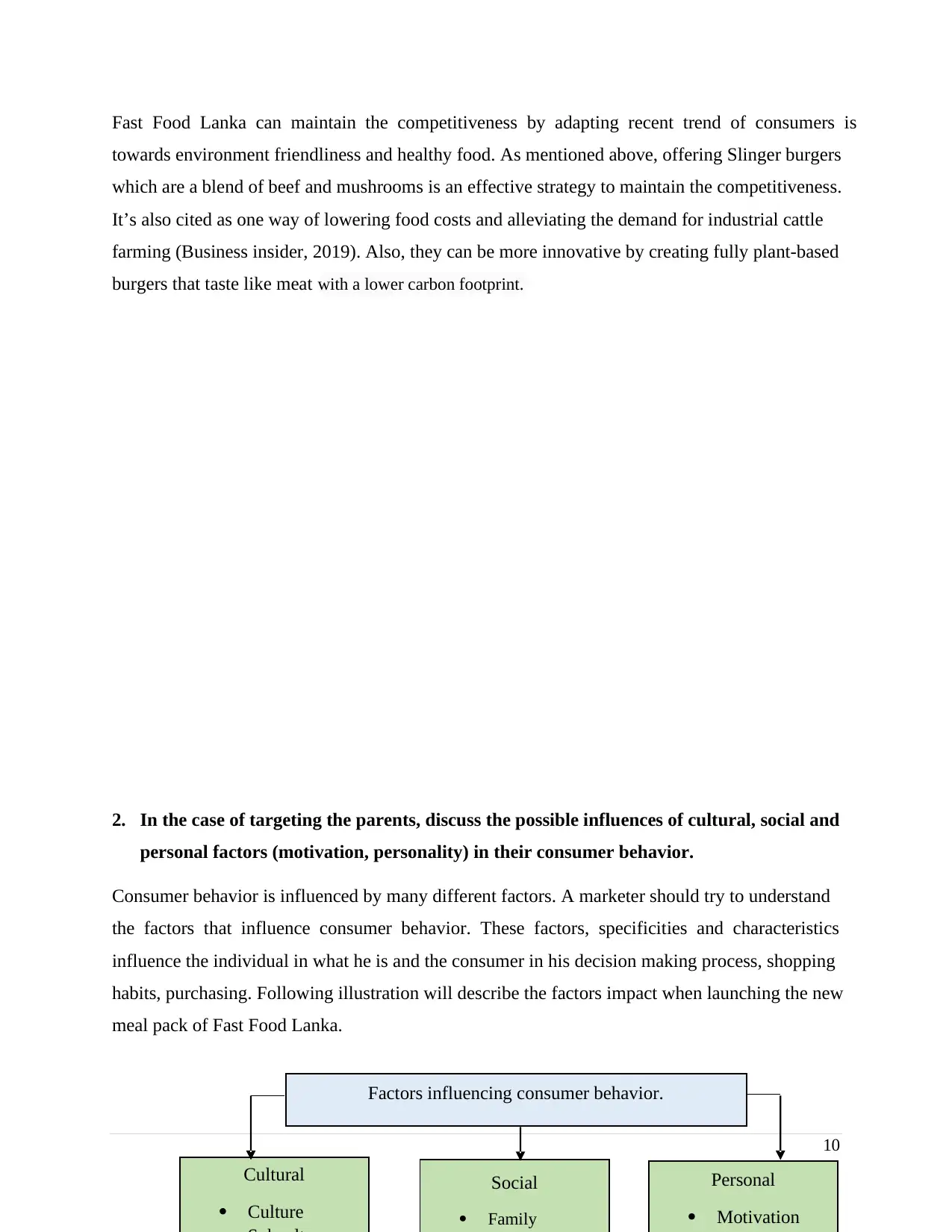
10
Fast Food Lanka can maintain the competitiveness by adapting recent trend of consumers is
towards environment friendliness and healthy food. As mentioned above, offering Slinger burgers
which are a blend of beef and mushrooms is an effective strategy to maintain the competitiveness.
It’s also cited as one way of lowering food costs and alleviating the demand for industrial cattle
farming (Business insider, 2019). Also, they can be more innovative by creating fully plant-based
burgers that taste like meat with a lower carbon footprint.
2. In the case of targeting the parents, discuss the possible influences of cultural, social and
personal factors (motivation, personality) in their consumer behavior.
Consumer behavior is influenced by many different factors. A marketer should try to understand
the factors that influence consumer behavior. These factors, specificities and characteristics
influence the individual in what he is and the consumer in his decision making process, shopping
habits, purchasing. Following illustration will describe the factors impact when launching the new
meal pack of Fast Food Lanka.
Factors influencing consumer behavior.
Cultural
Culture
Social
Family
Personal
Motivation
Fast Food Lanka can maintain the competitiveness by adapting recent trend of consumers is
towards environment friendliness and healthy food. As mentioned above, offering Slinger burgers
which are a blend of beef and mushrooms is an effective strategy to maintain the competitiveness.
It’s also cited as one way of lowering food costs and alleviating the demand for industrial cattle
farming (Business insider, 2019). Also, they can be more innovative by creating fully plant-based
burgers that taste like meat with a lower carbon footprint.
2. In the case of targeting the parents, discuss the possible influences of cultural, social and
personal factors (motivation, personality) in their consumer behavior.
Consumer behavior is influenced by many different factors. A marketer should try to understand
the factors that influence consumer behavior. These factors, specificities and characteristics
influence the individual in what he is and the consumer in his decision making process, shopping
habits, purchasing. Following illustration will describe the factors impact when launching the new
meal pack of Fast Food Lanka.
Factors influencing consumer behavior.
Cultural
Culture
Social
Family
Personal
Motivation
Secure Best Marks with AI Grader
Need help grading? Try our AI Grader for instant feedback on your assignments.
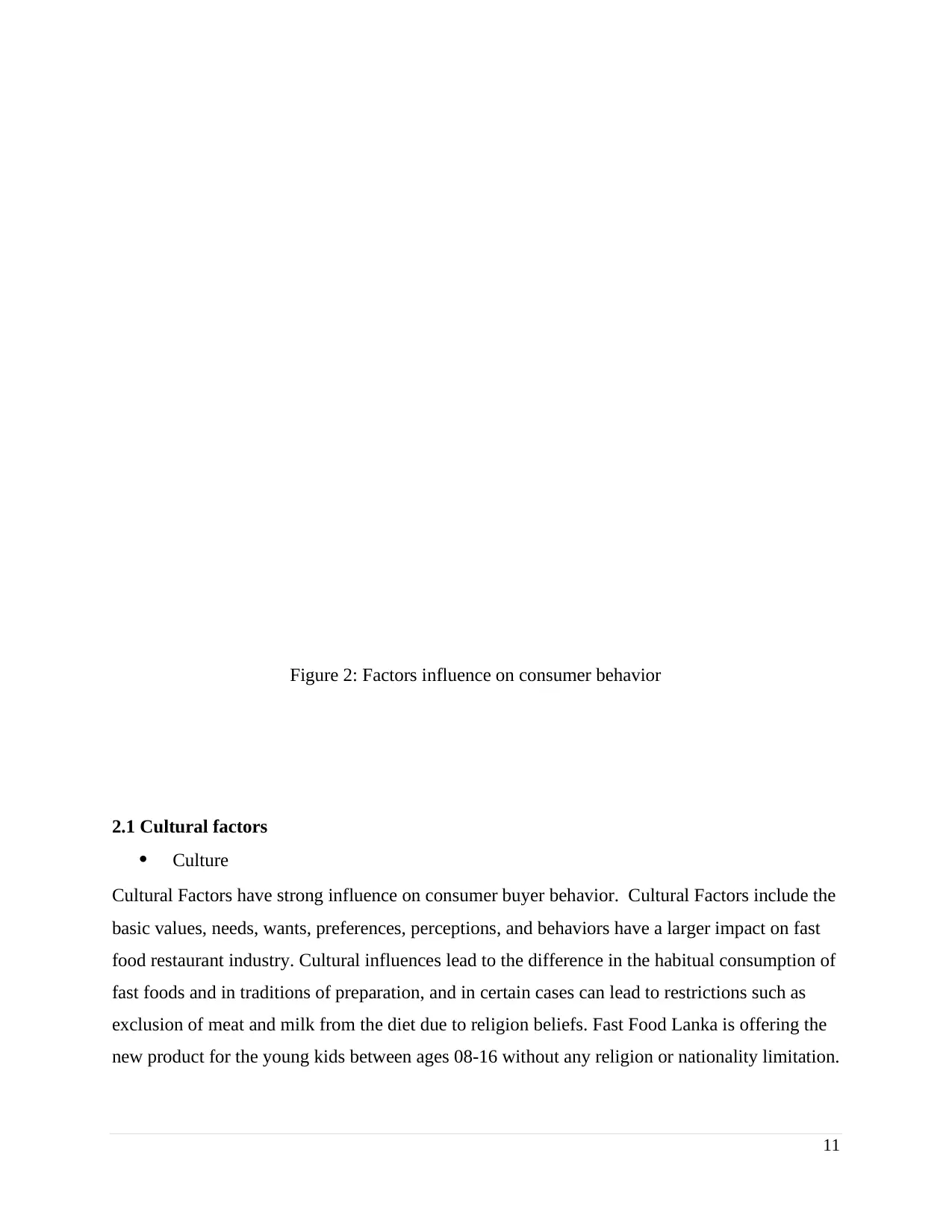
11
Figure 2: Factors influence on consumer behavior
2.1 Cultural factors
Culture
Cultural Factors have strong influence on consumer buyer behavior. Cultural Factors include the
basic values, needs, wants, preferences, perceptions, and behaviors have a larger impact on fast
food restaurant industry. Cultural influences lead to the difference in the habitual consumption of
fast foods and in traditions of preparation, and in certain cases can lead to restrictions such as
exclusion of meat and milk from the diet due to religion beliefs. Fast Food Lanka is offering the
new product for the young kids between ages 08-16 without any religion or nationality limitation.
Figure 2: Factors influence on consumer behavior
2.1 Cultural factors
Culture
Cultural Factors have strong influence on consumer buyer behavior. Cultural Factors include the
basic values, needs, wants, preferences, perceptions, and behaviors have a larger impact on fast
food restaurant industry. Cultural influences lead to the difference in the habitual consumption of
fast foods and in traditions of preparation, and in certain cases can lead to restrictions such as
exclusion of meat and milk from the diet due to religion beliefs. Fast Food Lanka is offering the
new product for the young kids between ages 08-16 without any religion or nationality limitation.
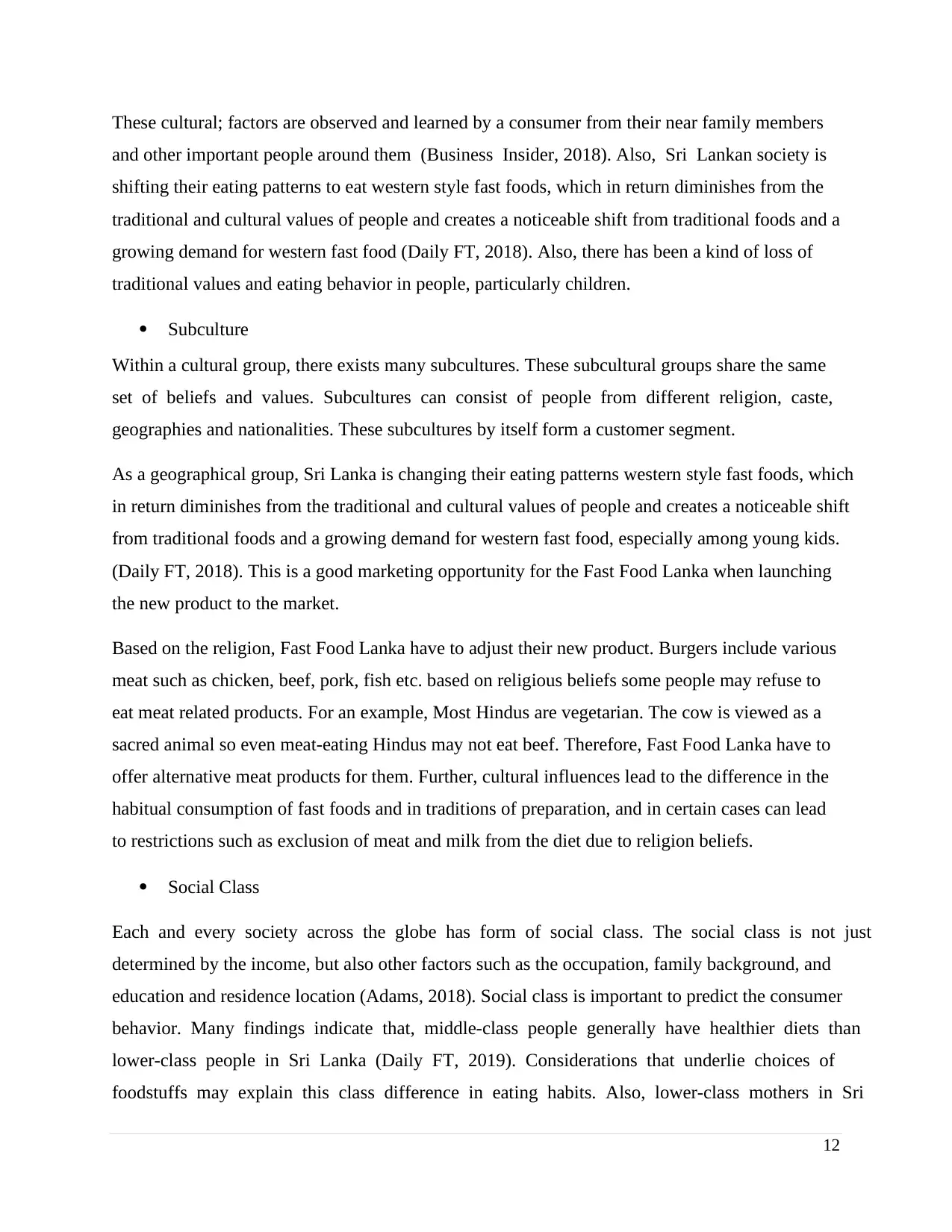
12
These cultural; factors are observed and learned by a consumer from their near family members
and other important people around them (Business Insider, 2018). Also, Sri Lankan society is
shifting their eating patterns to eat western style fast foods, which in return diminishes from the
traditional and cultural values of people and creates a noticeable shift from traditional foods and a
growing demand for western fast food (Daily FT, 2018). Also, there has been a kind of loss of
traditional values and eating behavior in people, particularly children.
Subculture
Within a cultural group, there exists many subcultures. These subcultural groups share the same
set of beliefs and values. Subcultures can consist of people from different religion, caste,
geographies and nationalities. These subcultures by itself form a customer segment.
As a geographical group, Sri Lanka is changing their eating patterns western style fast foods, which
in return diminishes from the traditional and cultural values of people and creates a noticeable shift
from traditional foods and a growing demand for western fast food, especially among young kids.
(Daily FT, 2018). This is a good marketing opportunity for the Fast Food Lanka when launching
the new product to the market.
Based on the religion, Fast Food Lanka have to adjust their new product. Burgers include various
meat such as chicken, beef, pork, fish etc. based on religious beliefs some people may refuse to
eat meat related products. For an example, Most Hindus are vegetarian. The cow is viewed as a
sacred animal so even meat-eating Hindus may not eat beef. Therefore, Fast Food Lanka have to
offer alternative meat products for them. Further, cultural influences lead to the difference in the
habitual consumption of fast foods and in traditions of preparation, and in certain cases can lead
to restrictions such as exclusion of meat and milk from the diet due to religion beliefs.
Social Class
Each and every society across the globe has form of social class. The social class is not just
determined by the income, but also other factors such as the occupation, family background, and
education and residence location (Adams, 2018). Social class is important to predict the consumer
behavior. Many findings indicate that, middle-class people generally have healthier diets than
lower-class people in Sri Lanka (Daily FT, 2019). Considerations that underlie choices of
foodstuffs may explain this class difference in eating habits. Also, lower-class mothers in Sri
These cultural; factors are observed and learned by a consumer from their near family members
and other important people around them (Business Insider, 2018). Also, Sri Lankan society is
shifting their eating patterns to eat western style fast foods, which in return diminishes from the
traditional and cultural values of people and creates a noticeable shift from traditional foods and a
growing demand for western fast food (Daily FT, 2018). Also, there has been a kind of loss of
traditional values and eating behavior in people, particularly children.
Subculture
Within a cultural group, there exists many subcultures. These subcultural groups share the same
set of beliefs and values. Subcultures can consist of people from different religion, caste,
geographies and nationalities. These subcultures by itself form a customer segment.
As a geographical group, Sri Lanka is changing their eating patterns western style fast foods, which
in return diminishes from the traditional and cultural values of people and creates a noticeable shift
from traditional foods and a growing demand for western fast food, especially among young kids.
(Daily FT, 2018). This is a good marketing opportunity for the Fast Food Lanka when launching
the new product to the market.
Based on the religion, Fast Food Lanka have to adjust their new product. Burgers include various
meat such as chicken, beef, pork, fish etc. based on religious beliefs some people may refuse to
eat meat related products. For an example, Most Hindus are vegetarian. The cow is viewed as a
sacred animal so even meat-eating Hindus may not eat beef. Therefore, Fast Food Lanka have to
offer alternative meat products for them. Further, cultural influences lead to the difference in the
habitual consumption of fast foods and in traditions of preparation, and in certain cases can lead
to restrictions such as exclusion of meat and milk from the diet due to religion beliefs.
Social Class
Each and every society across the globe has form of social class. The social class is not just
determined by the income, but also other factors such as the occupation, family background, and
education and residence location (Adams, 2018). Social class is important to predict the consumer
behavior. Many findings indicate that, middle-class people generally have healthier diets than
lower-class people in Sri Lanka (Daily FT, 2019). Considerations that underlie choices of
foodstuffs may explain this class difference in eating habits. Also, lower-class mothers in Sri
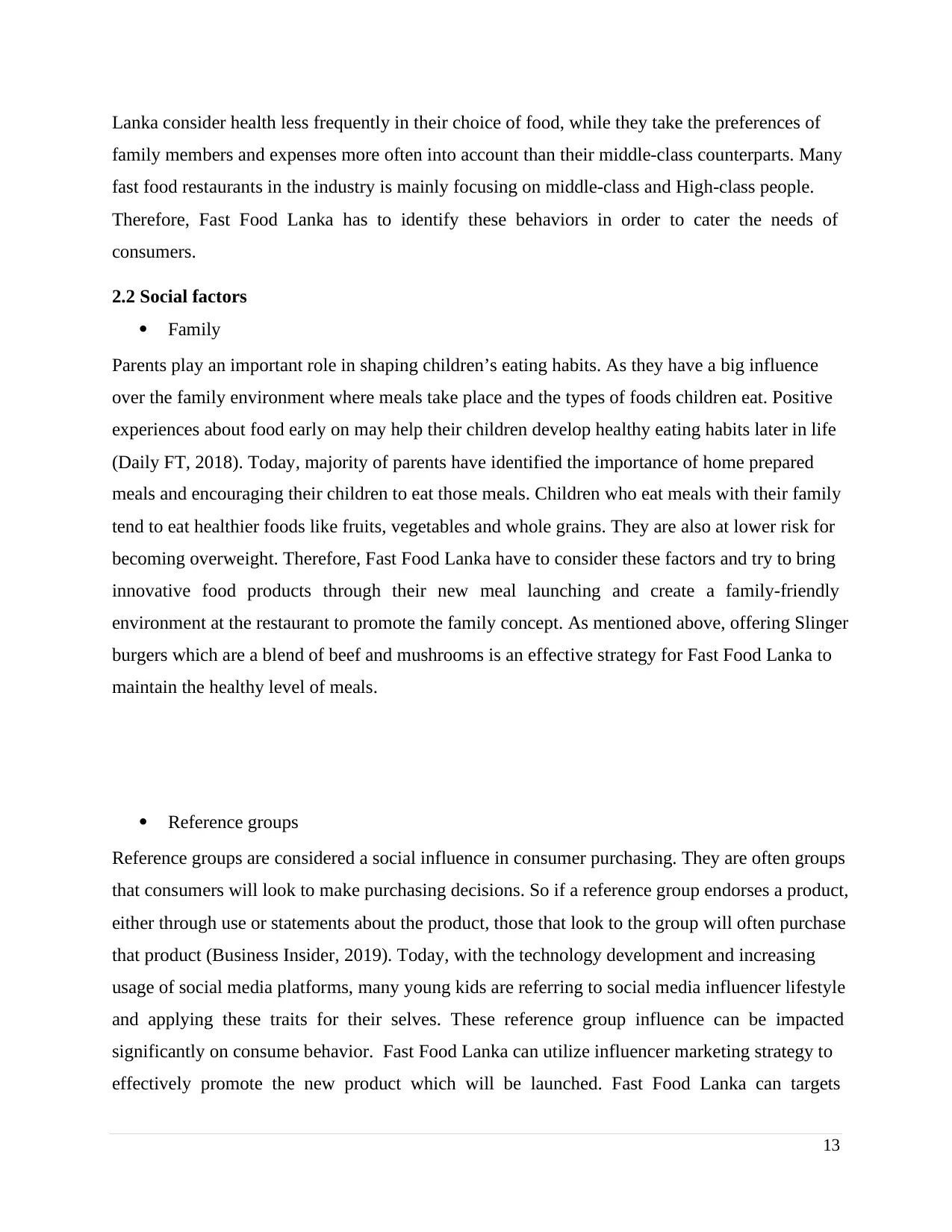
13
Lanka consider health less frequently in their choice of food, while they take the preferences of
family members and expenses more often into account than their middle-class counterparts. Many
fast food restaurants in the industry is mainly focusing on middle-class and High-class people.
Therefore, Fast Food Lanka has to identify these behaviors in order to cater the needs of
consumers.
2.2 Social factors
Family
Parents play an important role in shaping children’s eating habits. As they have a big influence
over the family environment where meals take place and the types of foods children eat. Positive
experiences about food early on may help their children develop healthy eating habits later in life
(Daily FT, 2018). Today, majority of parents have identified the importance of home prepared
meals and encouraging their children to eat those meals. Children who eat meals with their family
tend to eat healthier foods like fruits, vegetables and whole grains. They are also at lower risk for
becoming overweight. Therefore, Fast Food Lanka have to consider these factors and try to bring
innovative food products through their new meal launching and create a family-friendly
environment at the restaurant to promote the family concept. As mentioned above, offering Slinger
burgers which are a blend of beef and mushrooms is an effective strategy for Fast Food Lanka to
maintain the healthy level of meals.
Reference groups
Reference groups are considered a social influence in consumer purchasing. They are often groups
that consumers will look to make purchasing decisions. So if a reference group endorses a product,
either through use or statements about the product, those that look to the group will often purchase
that product (Business Insider, 2019). Today, with the technology development and increasing
usage of social media platforms, many young kids are referring to social media influencer lifestyle
and applying these traits for their selves. These reference group influence can be impacted
significantly on consume behavior. Fast Food Lanka can utilize influencer marketing strategy to
effectively promote the new product which will be launched. Fast Food Lanka can targets
Lanka consider health less frequently in their choice of food, while they take the preferences of
family members and expenses more often into account than their middle-class counterparts. Many
fast food restaurants in the industry is mainly focusing on middle-class and High-class people.
Therefore, Fast Food Lanka has to identify these behaviors in order to cater the needs of
consumers.
2.2 Social factors
Family
Parents play an important role in shaping children’s eating habits. As they have a big influence
over the family environment where meals take place and the types of foods children eat. Positive
experiences about food early on may help their children develop healthy eating habits later in life
(Daily FT, 2018). Today, majority of parents have identified the importance of home prepared
meals and encouraging their children to eat those meals. Children who eat meals with their family
tend to eat healthier foods like fruits, vegetables and whole grains. They are also at lower risk for
becoming overweight. Therefore, Fast Food Lanka have to consider these factors and try to bring
innovative food products through their new meal launching and create a family-friendly
environment at the restaurant to promote the family concept. As mentioned above, offering Slinger
burgers which are a blend of beef and mushrooms is an effective strategy for Fast Food Lanka to
maintain the healthy level of meals.
Reference groups
Reference groups are considered a social influence in consumer purchasing. They are often groups
that consumers will look to make purchasing decisions. So if a reference group endorses a product,
either through use or statements about the product, those that look to the group will often purchase
that product (Business Insider, 2019). Today, with the technology development and increasing
usage of social media platforms, many young kids are referring to social media influencer lifestyle
and applying these traits for their selves. These reference group influence can be impacted
significantly on consume behavior. Fast Food Lanka can utilize influencer marketing strategy to
effectively promote the new product which will be launched. Fast Food Lanka can targets
Paraphrase This Document
Need a fresh take? Get an instant paraphrase of this document with our AI Paraphraser
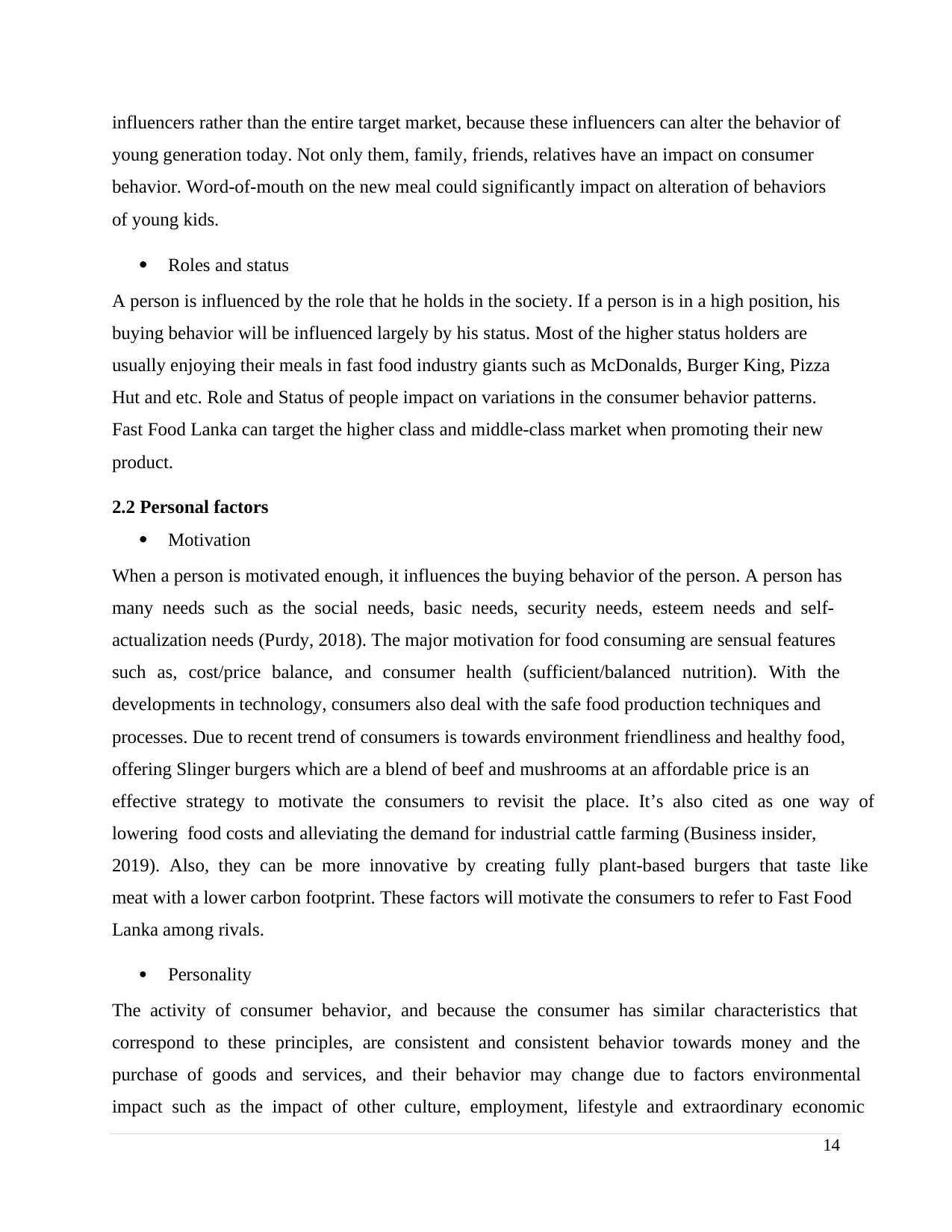
14
influencers rather than the entire target market, because these influencers can alter the behavior of
young generation today. Not only them, family, friends, relatives have an impact on consumer
behavior. Word-of-mouth on the new meal could significantly impact on alteration of behaviors
of young kids.
Roles and status
A person is influenced by the role that he holds in the society. If a person is in a high position, his
buying behavior will be influenced largely by his status. Most of the higher status holders are
usually enjoying their meals in fast food industry giants such as McDonalds, Burger King, Pizza
Hut and etc. Role and Status of people impact on variations in the consumer behavior patterns.
Fast Food Lanka can target the higher class and middle-class market when promoting their new
product.
2.2 Personal factors
Motivation
When a person is motivated enough, it influences the buying behavior of the person. A person has
many needs such as the social needs, basic needs, security needs, esteem needs and self-
actualization needs (Purdy, 2018). The major motivation for food consuming are sensual features
such as, cost/price balance, and consumer health (sufficient/balanced nutrition). With the
developments in technology, consumers also deal with the safe food production techniques and
processes. Due to recent trend of consumers is towards environment friendliness and healthy food,
offering Slinger burgers which are a blend of beef and mushrooms at an affordable price is an
effective strategy to motivate the consumers to revisit the place. It’s also cited as one way of
lowering food costs and alleviating the demand for industrial cattle farming (Business insider,
2019). Also, they can be more innovative by creating fully plant-based burgers that taste like
meat with a lower carbon footprint. These factors will motivate the consumers to refer to Fast Food
Lanka among rivals.
Personality
The activity of consumer behavior, and because the consumer has similar characteristics that
correspond to these principles, are consistent and consistent behavior towards money and the
purchase of goods and services, and their behavior may change due to factors environmental
impact such as the impact of other culture, employment, lifestyle and extraordinary economic
influencers rather than the entire target market, because these influencers can alter the behavior of
young generation today. Not only them, family, friends, relatives have an impact on consumer
behavior. Word-of-mouth on the new meal could significantly impact on alteration of behaviors
of young kids.
Roles and status
A person is influenced by the role that he holds in the society. If a person is in a high position, his
buying behavior will be influenced largely by his status. Most of the higher status holders are
usually enjoying their meals in fast food industry giants such as McDonalds, Burger King, Pizza
Hut and etc. Role and Status of people impact on variations in the consumer behavior patterns.
Fast Food Lanka can target the higher class and middle-class market when promoting their new
product.
2.2 Personal factors
Motivation
When a person is motivated enough, it influences the buying behavior of the person. A person has
many needs such as the social needs, basic needs, security needs, esteem needs and self-
actualization needs (Purdy, 2018). The major motivation for food consuming are sensual features
such as, cost/price balance, and consumer health (sufficient/balanced nutrition). With the
developments in technology, consumers also deal with the safe food production techniques and
processes. Due to recent trend of consumers is towards environment friendliness and healthy food,
offering Slinger burgers which are a blend of beef and mushrooms at an affordable price is an
effective strategy to motivate the consumers to revisit the place. It’s also cited as one way of
lowering food costs and alleviating the demand for industrial cattle farming (Business insider,
2019). Also, they can be more innovative by creating fully plant-based burgers that taste like
meat with a lower carbon footprint. These factors will motivate the consumers to refer to Fast Food
Lanka among rivals.
Personality
The activity of consumer behavior, and because the consumer has similar characteristics that
correspond to these principles, are consistent and consistent behavior towards money and the
purchase of goods and services, and their behavior may change due to factors environmental
impact such as the impact of other culture, employment, lifestyle and extraordinary economic
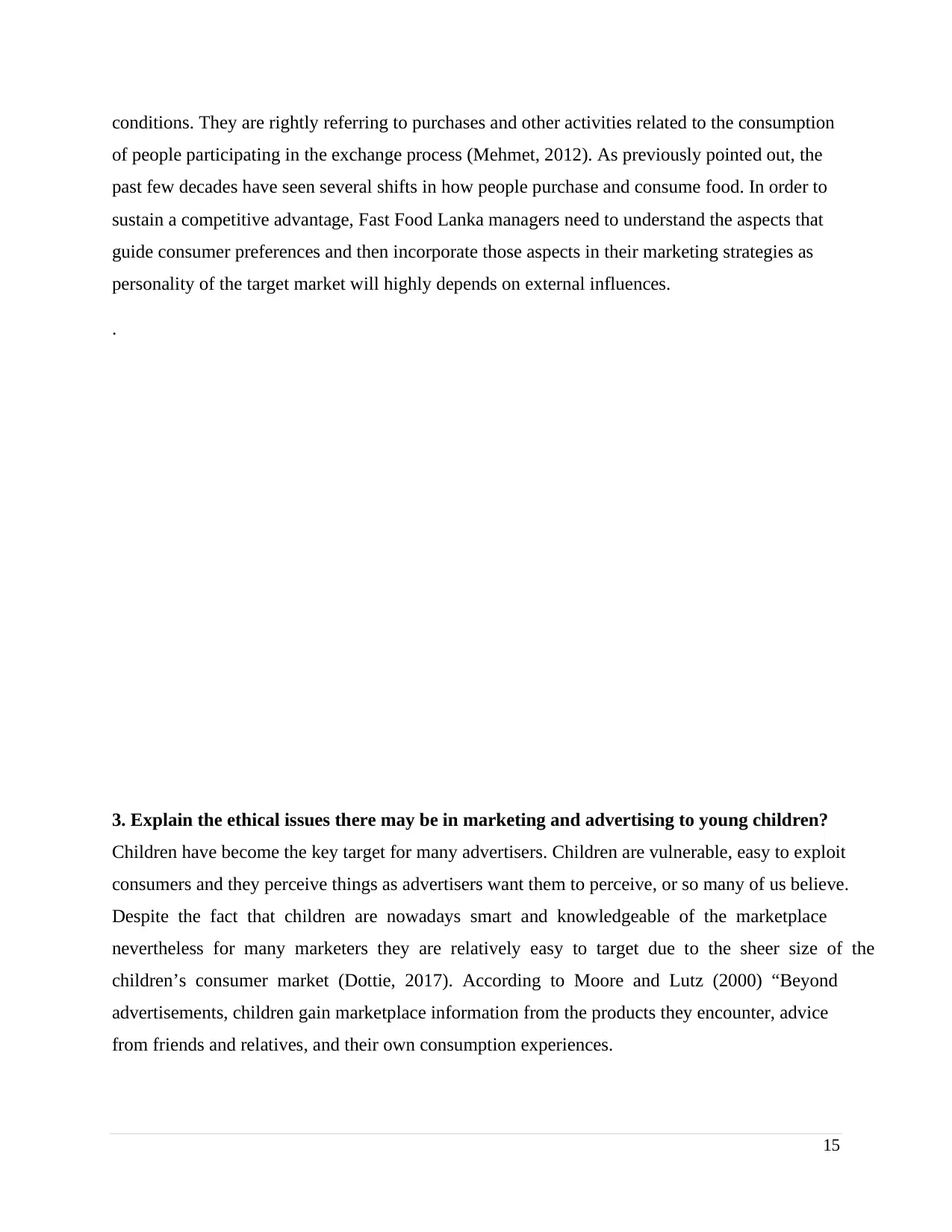
15
conditions. They are rightly referring to purchases and other activities related to the consumption
of people participating in the exchange process (Mehmet, 2012). As previously pointed out, the
past few decades have seen several shifts in how people purchase and consume food. In order to
sustain a competitive advantage, Fast Food Lanka managers need to understand the aspects that
guide consumer preferences and then incorporate those aspects in their marketing strategies as
personality of the target market will highly depends on external influences.
.
3. Explain the ethical issues there may be in marketing and advertising to young children?
Children have become the key target for many advertisers. Children are vulnerable, easy to exploit
consumers and they perceive things as advertisers want them to perceive, or so many of us believe.
Despite the fact that children are nowadays smart and knowledgeable of the marketplace
nevertheless for many marketers they are relatively easy to target due to the sheer size of the
children’s consumer market (Dottie, 2017). According to Moore and Lutz (2000) “Beyond
advertisements, children gain marketplace information from the products they encounter, advice
from friends and relatives, and their own consumption experiences.
conditions. They are rightly referring to purchases and other activities related to the consumption
of people participating in the exchange process (Mehmet, 2012). As previously pointed out, the
past few decades have seen several shifts in how people purchase and consume food. In order to
sustain a competitive advantage, Fast Food Lanka managers need to understand the aspects that
guide consumer preferences and then incorporate those aspects in their marketing strategies as
personality of the target market will highly depends on external influences.
.
3. Explain the ethical issues there may be in marketing and advertising to young children?
Children have become the key target for many advertisers. Children are vulnerable, easy to exploit
consumers and they perceive things as advertisers want them to perceive, or so many of us believe.
Despite the fact that children are nowadays smart and knowledgeable of the marketplace
nevertheless for many marketers they are relatively easy to target due to the sheer size of the
children’s consumer market (Dottie, 2017). According to Moore and Lutz (2000) “Beyond
advertisements, children gain marketplace information from the products they encounter, advice
from friends and relatives, and their own consumption experiences.
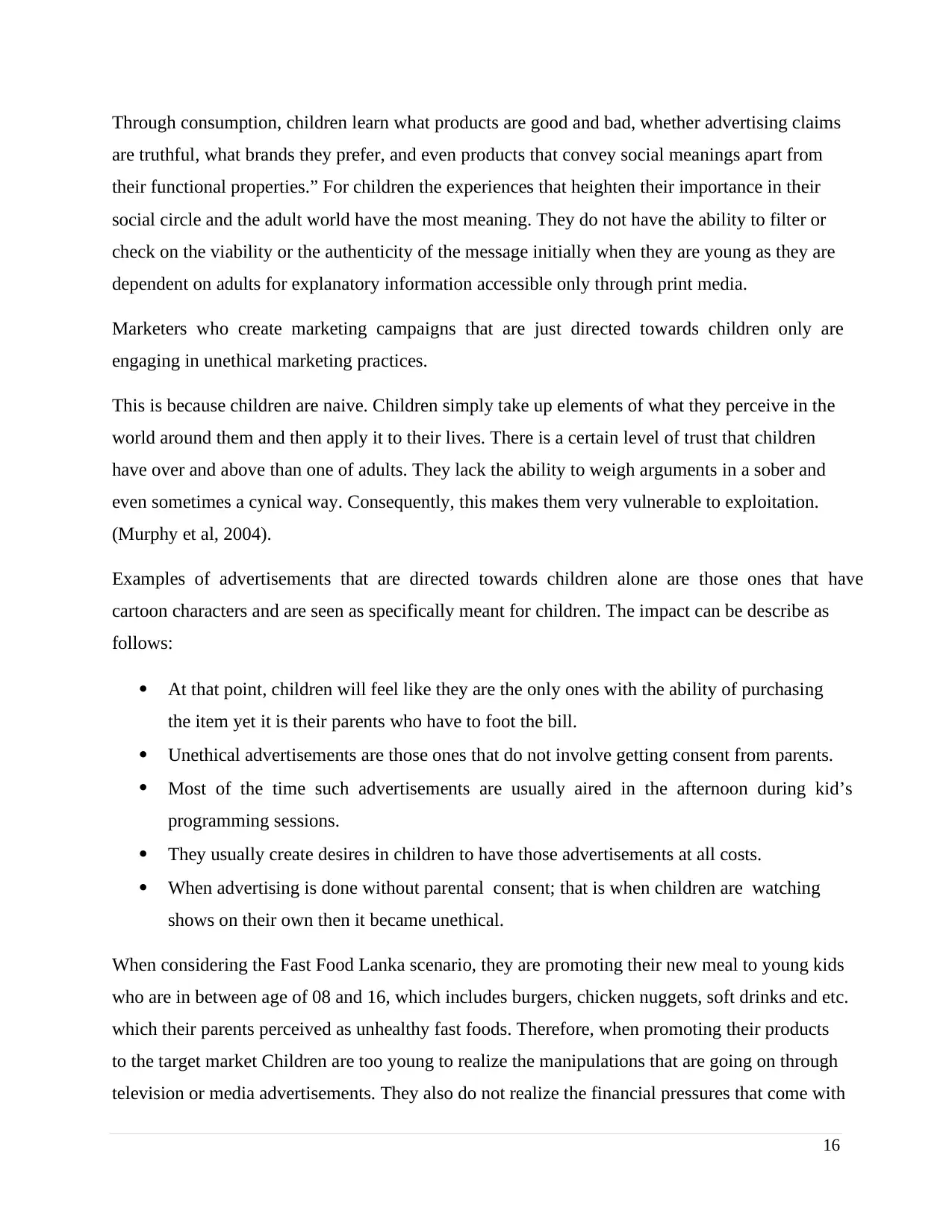
16
Through consumption, children learn what products are good and bad, whether advertising claims
are truthful, what brands they prefer, and even products that convey social meanings apart from
their functional properties.” For children the experiences that heighten their importance in their
social circle and the adult world have the most meaning. They do not have the ability to filter or
check on the viability or the authenticity of the message initially when they are young as they are
dependent on adults for explanatory information accessible only through print media.
Marketers who create marketing campaigns that are just directed towards children only are
engaging in unethical marketing practices.
This is because children are naive. Children simply take up elements of what they perceive in the
world around them and then apply it to their lives. There is a certain level of trust that children
have over and above than one of adults. They lack the ability to weigh arguments in a sober and
even sometimes a cynical way. Consequently, this makes them very vulnerable to exploitation.
(Murphy et al, 2004).
Examples of advertisements that are directed towards children alone are those ones that have
cartoon characters and are seen as specifically meant for children. The impact can be describe as
follows:
At that point, children will feel like they are the only ones with the ability of purchasing
the item yet it is their parents who have to foot the bill.
Unethical advertisements are those ones that do not involve getting consent from parents.
Most of the time such advertisements are usually aired in the afternoon during kid’s
programming sessions.
They usually create desires in children to have those advertisements at all costs.
When advertising is done without parental consent; that is when children are watching
shows on their own then it became unethical.
When considering the Fast Food Lanka scenario, they are promoting their new meal to young kids
who are in between age of 08 and 16, which includes burgers, chicken nuggets, soft drinks and etc.
which their parents perceived as unhealthy fast foods. Therefore, when promoting their products
to the target market Children are too young to realize the manipulations that are going on through
television or media advertisements. They also do not realize the financial pressures that come with
Through consumption, children learn what products are good and bad, whether advertising claims
are truthful, what brands they prefer, and even products that convey social meanings apart from
their functional properties.” For children the experiences that heighten their importance in their
social circle and the adult world have the most meaning. They do not have the ability to filter or
check on the viability or the authenticity of the message initially when they are young as they are
dependent on adults for explanatory information accessible only through print media.
Marketers who create marketing campaigns that are just directed towards children only are
engaging in unethical marketing practices.
This is because children are naive. Children simply take up elements of what they perceive in the
world around them and then apply it to their lives. There is a certain level of trust that children
have over and above than one of adults. They lack the ability to weigh arguments in a sober and
even sometimes a cynical way. Consequently, this makes them very vulnerable to exploitation.
(Murphy et al, 2004).
Examples of advertisements that are directed towards children alone are those ones that have
cartoon characters and are seen as specifically meant for children. The impact can be describe as
follows:
At that point, children will feel like they are the only ones with the ability of purchasing
the item yet it is their parents who have to foot the bill.
Unethical advertisements are those ones that do not involve getting consent from parents.
Most of the time such advertisements are usually aired in the afternoon during kid’s
programming sessions.
They usually create desires in children to have those advertisements at all costs.
When advertising is done without parental consent; that is when children are watching
shows on their own then it became unethical.
When considering the Fast Food Lanka scenario, they are promoting their new meal to young kids
who are in between age of 08 and 16, which includes burgers, chicken nuggets, soft drinks and etc.
which their parents perceived as unhealthy fast foods. Therefore, when promoting their products
to the target market Children are too young to realize the manipulations that are going on through
television or media advertisements. They also do not realize the financial pressures that come with
Secure Best Marks with AI Grader
Need help grading? Try our AI Grader for instant feedback on your assignments.
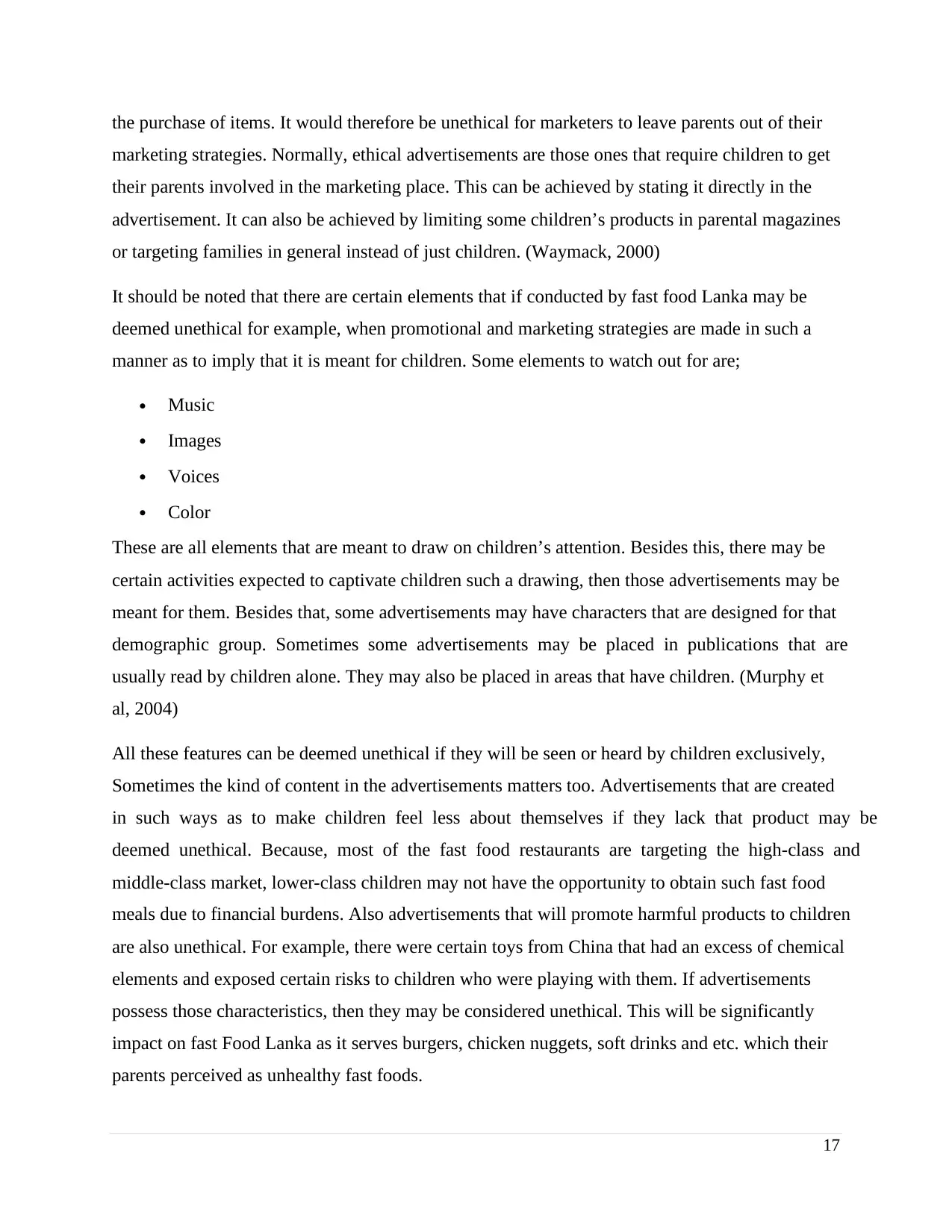
17
the purchase of items. It would therefore be unethical for marketers to leave parents out of their
marketing strategies. Normally, ethical advertisements are those ones that require children to get
their parents involved in the marketing place. This can be achieved by stating it directly in the
advertisement. It can also be achieved by limiting some children’s products in parental magazines
or targeting families in general instead of just children. (Waymack, 2000)
It should be noted that there are certain elements that if conducted by fast food Lanka may be
deemed unethical for example, when promotional and marketing strategies are made in such a
manner as to imply that it is meant for children. Some elements to watch out for are;
Music
Images
Voices
Color
These are all elements that are meant to draw on children’s attention. Besides this, there may be
certain activities expected to captivate children such a drawing, then those advertisements may be
meant for them. Besides that, some advertisements may have characters that are designed for that
demographic group. Sometimes some advertisements may be placed in publications that are
usually read by children alone. They may also be placed in areas that have children. (Murphy et
al, 2004)
All these features can be deemed unethical if they will be seen or heard by children exclusively,
Sometimes the kind of content in the advertisements matters too. Advertisements that are created
in such ways as to make children feel less about themselves if they lack that product may be
deemed unethical. Because, most of the fast food restaurants are targeting the high-class and
middle-class market, lower-class children may not have the opportunity to obtain such fast food
meals due to financial burdens. Also advertisements that will promote harmful products to children
are also unethical. For example, there were certain toys from China that had an excess of chemical
elements and exposed certain risks to children who were playing with them. If advertisements
possess those characteristics, then they may be considered unethical. This will be significantly
impact on fast Food Lanka as it serves burgers, chicken nuggets, soft drinks and etc. which their
parents perceived as unhealthy fast foods.
the purchase of items. It would therefore be unethical for marketers to leave parents out of their
marketing strategies. Normally, ethical advertisements are those ones that require children to get
their parents involved in the marketing place. This can be achieved by stating it directly in the
advertisement. It can also be achieved by limiting some children’s products in parental magazines
or targeting families in general instead of just children. (Waymack, 2000)
It should be noted that there are certain elements that if conducted by fast food Lanka may be
deemed unethical for example, when promotional and marketing strategies are made in such a
manner as to imply that it is meant for children. Some elements to watch out for are;
Music
Images
Voices
Color
These are all elements that are meant to draw on children’s attention. Besides this, there may be
certain activities expected to captivate children such a drawing, then those advertisements may be
meant for them. Besides that, some advertisements may have characters that are designed for that
demographic group. Sometimes some advertisements may be placed in publications that are
usually read by children alone. They may also be placed in areas that have children. (Murphy et
al, 2004)
All these features can be deemed unethical if they will be seen or heard by children exclusively,
Sometimes the kind of content in the advertisements matters too. Advertisements that are created
in such ways as to make children feel less about themselves if they lack that product may be
deemed unethical. Because, most of the fast food restaurants are targeting the high-class and
middle-class market, lower-class children may not have the opportunity to obtain such fast food
meals due to financial burdens. Also advertisements that will promote harmful products to children
are also unethical. For example, there were certain toys from China that had an excess of chemical
elements and exposed certain risks to children who were playing with them. If advertisements
possess those characteristics, then they may be considered unethical. This will be significantly
impact on fast Food Lanka as it serves burgers, chicken nuggets, soft drinks and etc. which their
parents perceived as unhealthy fast foods.

18
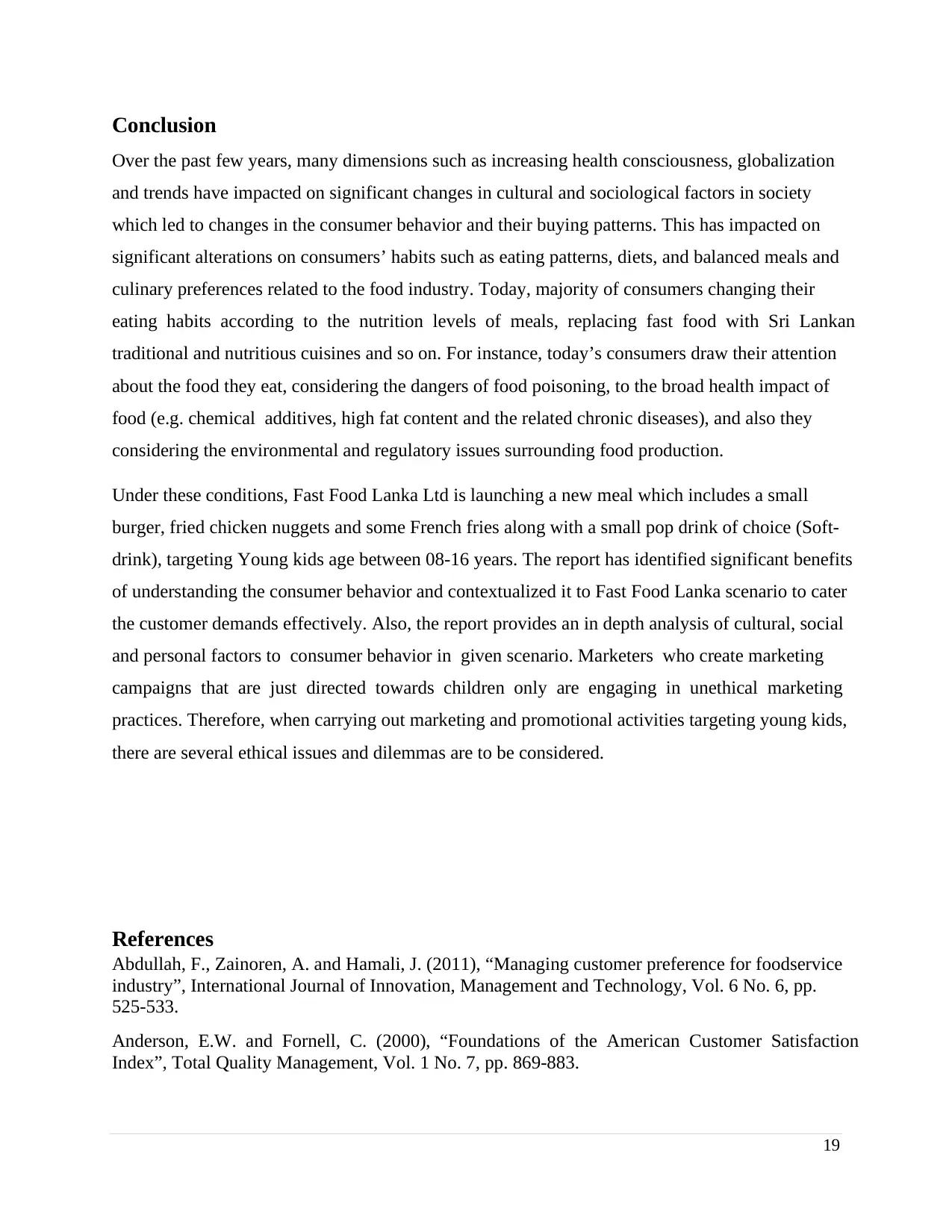
19
Conclusion
Over the past few years, many dimensions such as increasing health consciousness, globalization
and trends have impacted on significant changes in cultural and sociological factors in society
which led to changes in the consumer behavior and their buying patterns. This has impacted on
significant alterations on consumers’ habits such as eating patterns, diets, and balanced meals and
culinary preferences related to the food industry. Today, majority of consumers changing their
eating habits according to the nutrition levels of meals, replacing fast food with Sri Lankan
traditional and nutritious cuisines and so on. For instance, today’s consumers draw their attention
about the food they eat, considering the dangers of food poisoning, to the broad health impact of
food (e.g. chemical additives, high fat content and the related chronic diseases), and also they
considering the environmental and regulatory issues surrounding food production.
Under these conditions, Fast Food Lanka Ltd is launching a new meal which includes a small
burger, fried chicken nuggets and some French fries along with a small pop drink of choice (Soft-
drink), targeting Young kids age between 08-16 years. The report has identified significant benefits
of understanding the consumer behavior and contextualized it to Fast Food Lanka scenario to cater
the customer demands effectively. Also, the report provides an in depth analysis of cultural, social
and personal factors to consumer behavior in given scenario. Marketers who create marketing
campaigns that are just directed towards children only are engaging in unethical marketing
practices. Therefore, when carrying out marketing and promotional activities targeting young kids,
there are several ethical issues and dilemmas are to be considered.
References
Abdullah, F., Zainoren, A. and Hamali, J. (2011), “Managing customer preference for foodservice
industry”, International Journal of Innovation, Management and Technology, Vol. 6 No. 6, pp.
525-533.
Anderson, E.W. and Fornell, C. (2000), “Foundations of the American Customer Satisfaction
Index”, Total Quality Management, Vol. 1 No. 7, pp. 869-883.
Conclusion
Over the past few years, many dimensions such as increasing health consciousness, globalization
and trends have impacted on significant changes in cultural and sociological factors in society
which led to changes in the consumer behavior and their buying patterns. This has impacted on
significant alterations on consumers’ habits such as eating patterns, diets, and balanced meals and
culinary preferences related to the food industry. Today, majority of consumers changing their
eating habits according to the nutrition levels of meals, replacing fast food with Sri Lankan
traditional and nutritious cuisines and so on. For instance, today’s consumers draw their attention
about the food they eat, considering the dangers of food poisoning, to the broad health impact of
food (e.g. chemical additives, high fat content and the related chronic diseases), and also they
considering the environmental and regulatory issues surrounding food production.
Under these conditions, Fast Food Lanka Ltd is launching a new meal which includes a small
burger, fried chicken nuggets and some French fries along with a small pop drink of choice (Soft-
drink), targeting Young kids age between 08-16 years. The report has identified significant benefits
of understanding the consumer behavior and contextualized it to Fast Food Lanka scenario to cater
the customer demands effectively. Also, the report provides an in depth analysis of cultural, social
and personal factors to consumer behavior in given scenario. Marketers who create marketing
campaigns that are just directed towards children only are engaging in unethical marketing
practices. Therefore, when carrying out marketing and promotional activities targeting young kids,
there are several ethical issues and dilemmas are to be considered.
References
Abdullah, F., Zainoren, A. and Hamali, J. (2011), “Managing customer preference for foodservice
industry”, International Journal of Innovation, Management and Technology, Vol. 6 No. 6, pp.
525-533.
Anderson, E.W. and Fornell, C. (2000), “Foundations of the American Customer Satisfaction
Index”, Total Quality Management, Vol. 1 No. 7, pp. 869-883.
Paraphrase This Document
Need a fresh take? Get an instant paraphrase of this document with our AI Paraphraser
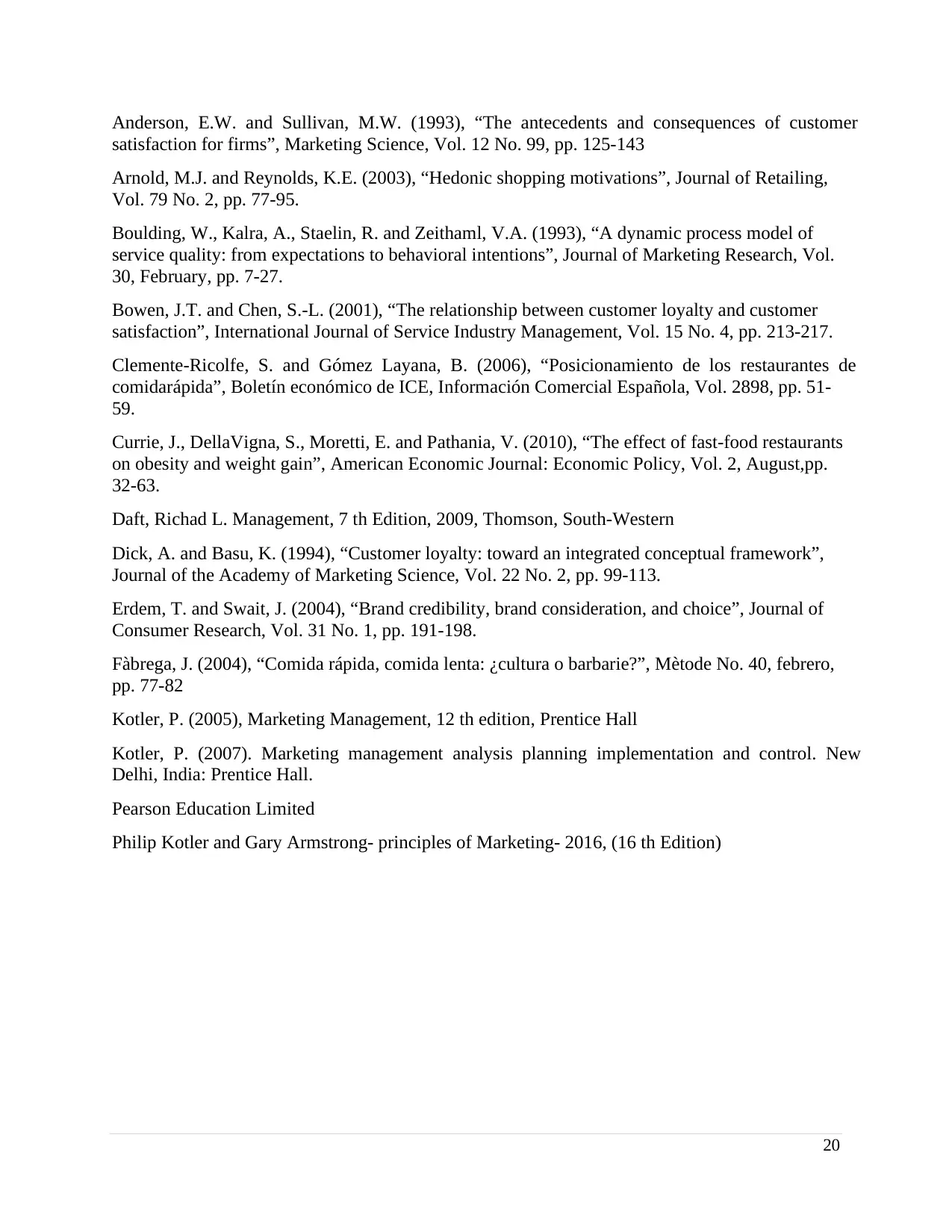
20
Anderson, E.W. and Sullivan, M.W. (1993), “The antecedents and consequences of customer
satisfaction for firms”, Marketing Science, Vol. 12 No. 99, pp. 125-143
Arnold, M.J. and Reynolds, K.E. (2003), “Hedonic shopping motivations”, Journal of Retailing,
Vol. 79 No. 2, pp. 77-95.
Boulding, W., Kalra, A., Staelin, R. and Zeithaml, V.A. (1993), “A dynamic process model of
service quality: from expectations to behavioral intentions”, Journal of Marketing Research, Vol.
30, February, pp. 7-27.
Bowen, J.T. and Chen, S.-L. (2001), “The relationship between customer loyalty and customer
satisfaction”, International Journal of Service Industry Management, Vol. 15 No. 4, pp. 213-217.
Clemente-Ricolfe, S. and Gómez Layana, B. (2006), “Posicionamiento de los restaurantes de
comidarápida”, Boletín económico de ICE, Información Comercial Española, Vol. 2898, pp. 51-
59.
Currie, J., DellaVigna, S., Moretti, E. and Pathania, V. (2010), “The effect of fast-food restaurants
on obesity and weight gain”, American Economic Journal: Economic Policy, Vol. 2, August,pp.
32-63.
Daft, Richad L. Management, 7 th Edition, 2009, Thomson, South-Western
Dick, A. and Basu, K. (1994), “Customer loyalty: toward an integrated conceptual framework”,
Journal of the Academy of Marketing Science, Vol. 22 No. 2, pp. 99-113.
Erdem, T. and Swait, J. (2004), “Brand credibility, brand consideration, and choice”, Journal of
Consumer Research, Vol. 31 No. 1, pp. 191-198.
Fàbrega, J. (2004), “Comida rápida, comida lenta: ¿cultura o barbarie?”, Mètode No. 40, febrero,
pp. 77-82
Kotler, P. (2005), Marketing Management, 12 th edition, Prentice Hall
Kotler, P. (2007). Marketing management analysis planning implementation and control. New
Delhi, India: Prentice Hall.
Pearson Education Limited
Philip Kotler and Gary Armstrong- principles of Marketing- 2016, (16 th Edition)
Anderson, E.W. and Sullivan, M.W. (1993), “The antecedents and consequences of customer
satisfaction for firms”, Marketing Science, Vol. 12 No. 99, pp. 125-143
Arnold, M.J. and Reynolds, K.E. (2003), “Hedonic shopping motivations”, Journal of Retailing,
Vol. 79 No. 2, pp. 77-95.
Boulding, W., Kalra, A., Staelin, R. and Zeithaml, V.A. (1993), “A dynamic process model of
service quality: from expectations to behavioral intentions”, Journal of Marketing Research, Vol.
30, February, pp. 7-27.
Bowen, J.T. and Chen, S.-L. (2001), “The relationship between customer loyalty and customer
satisfaction”, International Journal of Service Industry Management, Vol. 15 No. 4, pp. 213-217.
Clemente-Ricolfe, S. and Gómez Layana, B. (2006), “Posicionamiento de los restaurantes de
comidarápida”, Boletín económico de ICE, Información Comercial Española, Vol. 2898, pp. 51-
59.
Currie, J., DellaVigna, S., Moretti, E. and Pathania, V. (2010), “The effect of fast-food restaurants
on obesity and weight gain”, American Economic Journal: Economic Policy, Vol. 2, August,pp.
32-63.
Daft, Richad L. Management, 7 th Edition, 2009, Thomson, South-Western
Dick, A. and Basu, K. (1994), “Customer loyalty: toward an integrated conceptual framework”,
Journal of the Academy of Marketing Science, Vol. 22 No. 2, pp. 99-113.
Erdem, T. and Swait, J. (2004), “Brand credibility, brand consideration, and choice”, Journal of
Consumer Research, Vol. 31 No. 1, pp. 191-198.
Fàbrega, J. (2004), “Comida rápida, comida lenta: ¿cultura o barbarie?”, Mètode No. 40, febrero,
pp. 77-82
Kotler, P. (2005), Marketing Management, 12 th edition, Prentice Hall
Kotler, P. (2007). Marketing management analysis planning implementation and control. New
Delhi, India: Prentice Hall.
Pearson Education Limited
Philip Kotler and Gary Armstrong- principles of Marketing- 2016, (16 th Edition)
1 out of 20
Related Documents
Your All-in-One AI-Powered Toolkit for Academic Success.
+13062052269
info@desklib.com
Available 24*7 on WhatsApp / Email
![[object Object]](/_next/static/media/star-bottom.7253800d.svg)
Unlock your academic potential
© 2024 | Zucol Services PVT LTD | All rights reserved.




